A Rice Journey > Malaysia
馬來西亞 Malaysia
text: 顔仕宇 Nga Shi Yeu
photography: 劉國耀 Kok Yew
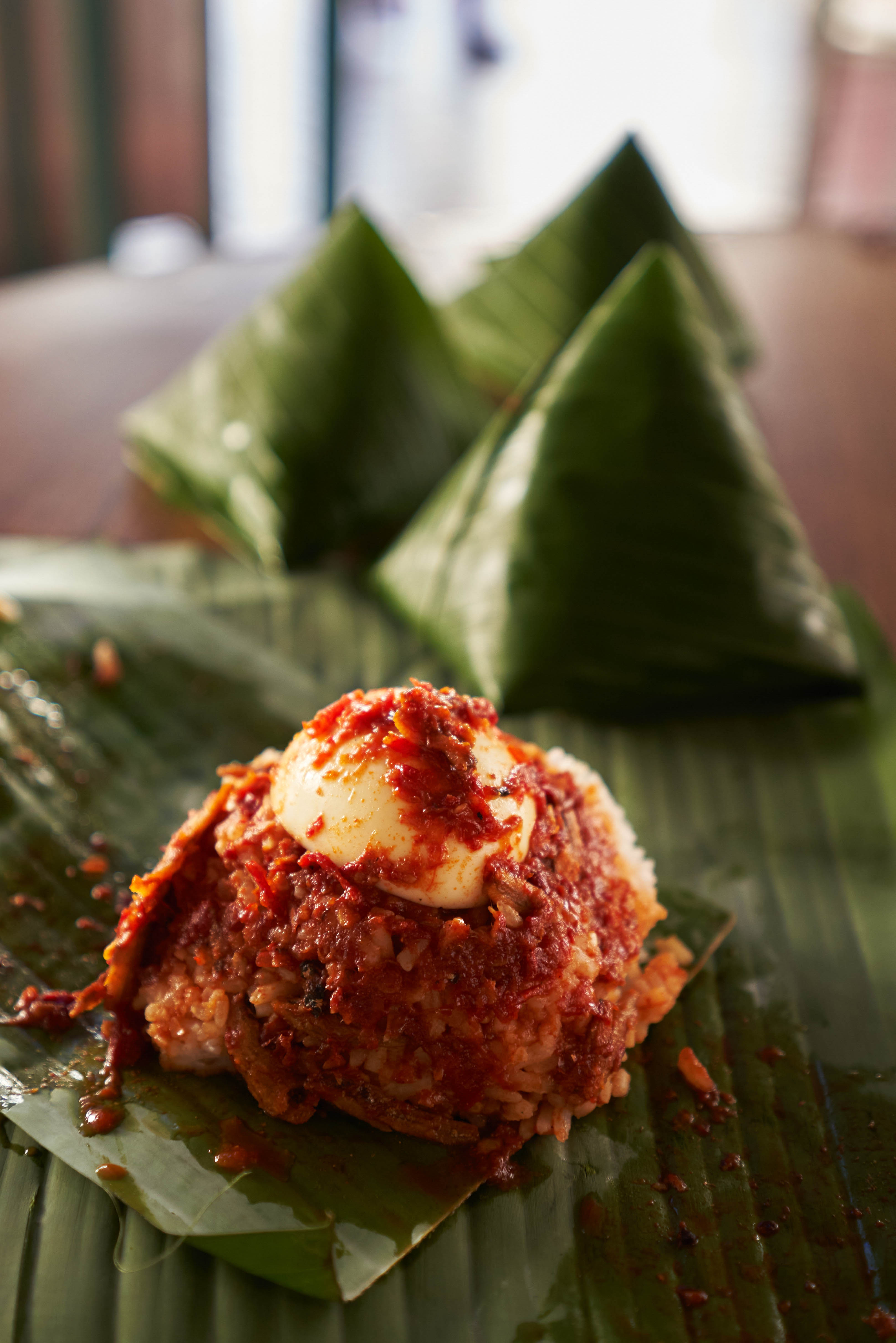

從馬來半島到婆羅洲的米食地景:馬來西亞
掀開馬來西亞的飲食版圖,縱使種類在地緣性上形形色色,但原料都離不開以澱粉質為主體的米元素。這篇文章挑選了五種在族群文化中具有代表性的主食,包括西部馬來半島的馬來族、印度裔穆斯林,再到東部婆羅洲的原住民族社群。從中介紹馬來西亞整體的米食地景在文化脈絡上的形變,也在部分米食的介紹中試圖呈現原先族群框架的突破,並衍生出跨族共享的國民象徵特性。The Rice Landscape from the Malay Peninsula to Borneo: Malaysia
When we look at the culinary map of Malaysia, we can find a wide variety of shapes and sizes in different regions but the ingredients are always starchy rice. In this article, the writer has selected five staple foods representative of different cultural groups including the Malays of the Malay Peninsula, Indian Muslims in Malaysia, indigenous communities in Borneo, etc., to detail the shifting cultural landscape of rice across Malaysia and present how rice dishes have transcended ethnic boundaries to become national dishes enjoyed by all ethnic groups in Malaysia.
椰漿飯 Nasi Lemak
Nasi lemak 字譯上可理解為「脂肪的飯」。脂肪(lemak)意指椰奶(新馬地區中譯為椰漿)的高熱量,其脂肪含量也使得米飯在煮熟之後呈現油亮的視覺感和香氣。關於命名來源,坊間有一種說法。相傳在15世紀位於馬來半島的馬六甲蘇丹國(Malacca Sultanate),有一對母女相依為命,女兒經常獨留在家做飯等待母親結束工作後回家。某天,女兒為了幫助勞累的母親提升食慾,想為白飯添加一些風味,於是在烹煮過程中加入南姜和七葉蘭。混合香料蒸熟的白飯呈現不同以往的滋味,讓母親品嚐之後為之驚訝,並追問這道米食的來頭。女兒聽後,脫口而出說「只是白飯,媽(nasi le, mak)」,但沒想到母親聽後產生誤會,以為nasi lemak是它的名稱,並因此向外傳開。有趣的是,該故事並無提到椰奶的添加,反而lemak一詞在意譯上也可反映米飯風味的「豐富濃郁」,而非僅是椰奶的脂肪含量。以椰奶入鍋煮米飯,這種烹調方式並非馬來西亞椰漿飯所專屬。印尼中爪哇地區的nasi liwet和雅加達一帶的nasi uduk等飯食也都有將椰奶混入米中調味的手法。廣義上,這些也都是椰漿飯的類型,然而印尼的椰漿飯在命名上並未強調椰奶成份的lemak,反而更為著重在煮食動作的意象上。例如uduk一詞指的是「混合」的意思,米飯混有多種香料烹煮而成,並在裝盤上以單一碗盤容器將各種配菜混搭在米飯之上;至於liwet則是印尼文裡的動詞,泛指透過專門的飯鍋和煮米調味手法來將米粒煮至剛好可食的狀態。
Nasi Lemak
Nasi lemak, translated literally, means “fat rice.” The “fat” generally refers to the high caloric content of coconut milk, which gives nasi lemak its sheen and fragrance when completed. As for its origins, there is folklore set in 15th Century Malacca Sultanate of a single mother living alone with her daughter. When the mother leaves for work every day, the daughter stays at home to cook and wait for her mother’s return. To entice her weary mother to eat more and introduce some additional flavors to the rice, the daughter adds galangal and pandan, giving it a completely different flavor profile. The mother, tasting the rice, is in awe and asks the daughter what the rice is. The daughter responded, without missing a beat, “Nasi le, Mak! (Rice, mother!)” The mom misheard and took nasi lemak to be the name of the rice. The dish, therefore, started to spread across the region. Interestingly enough, the story mentions nothing about the addition of coconut milk, once again reflecting that lemak refers to the rich and robust flavors of the herbal rice rather than simply the caloric content of coconut milk.
Cooking rice with coconut milk is not a technique unique to the nasi lemak of Malay cuisine. Indonesia’s Java and Jakarta both have rice dishes where the rice is cooked with coconut milk, called nasi liwet and nasi uduk, respectively. Broadly speaking, both Indonesian coconut milk rice dishes are variations of nasi lemak but neither emphasizes the richness (lemak) of coconut milk in their name, spotlighting the motions of cooking. The term uduk refers to “mixed,” as in the rice is prepared by mixing multiple spices and then served on a platter with many different sides. Liwet, on the other hand, is a verb in Indonesian that generally refers to using specific rice pots and cooking techniques to cook the rice until it is just soft enough to eat.

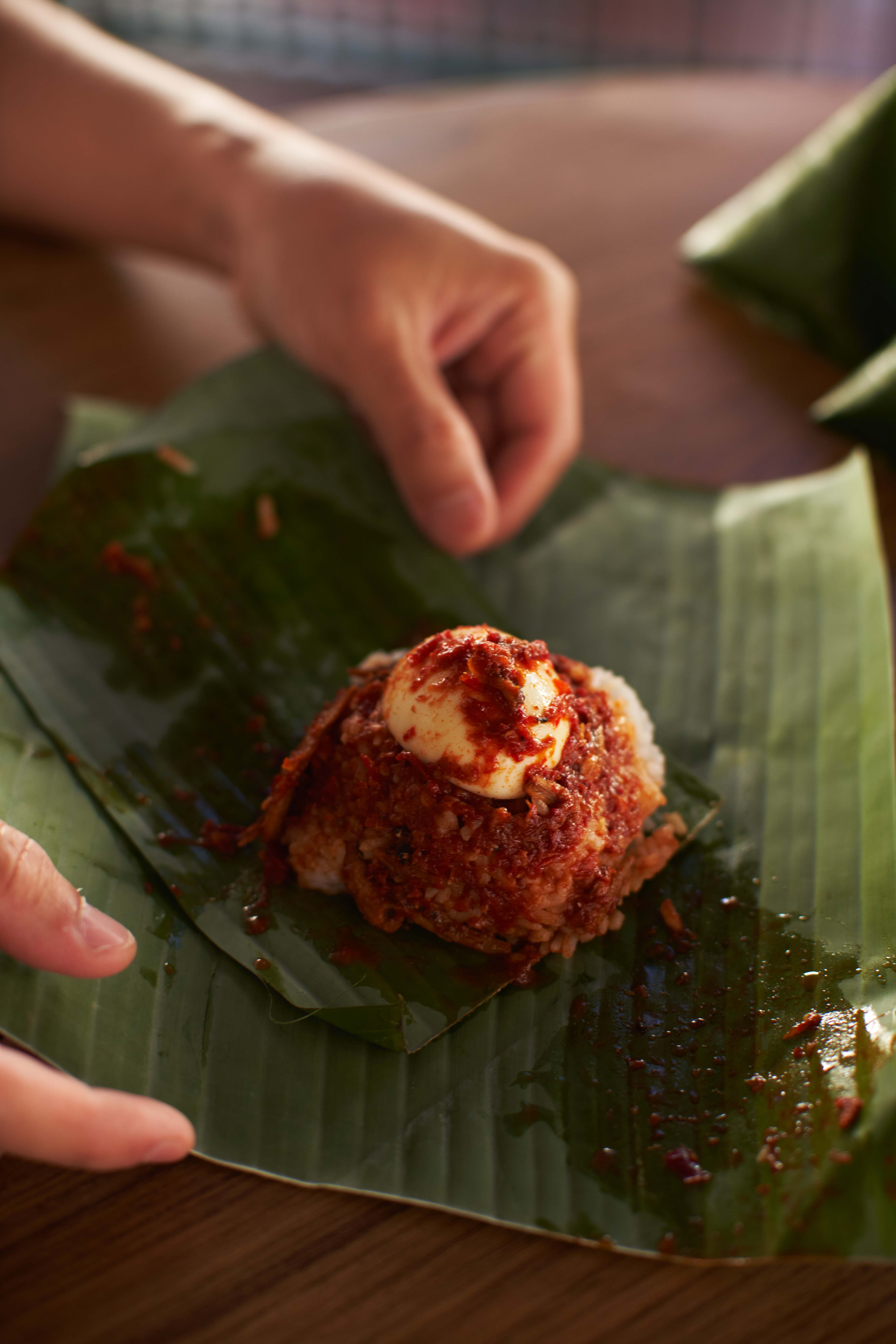
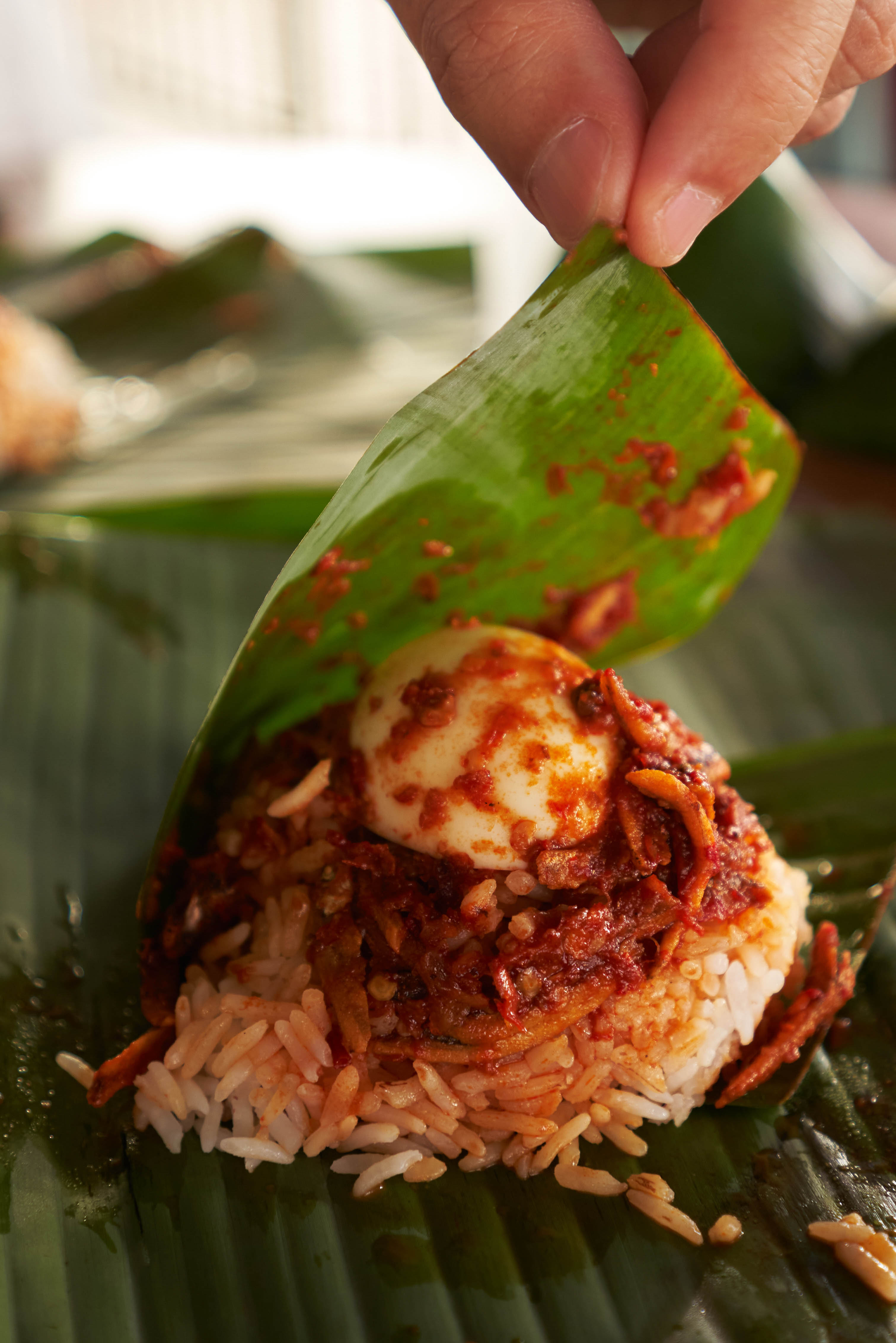

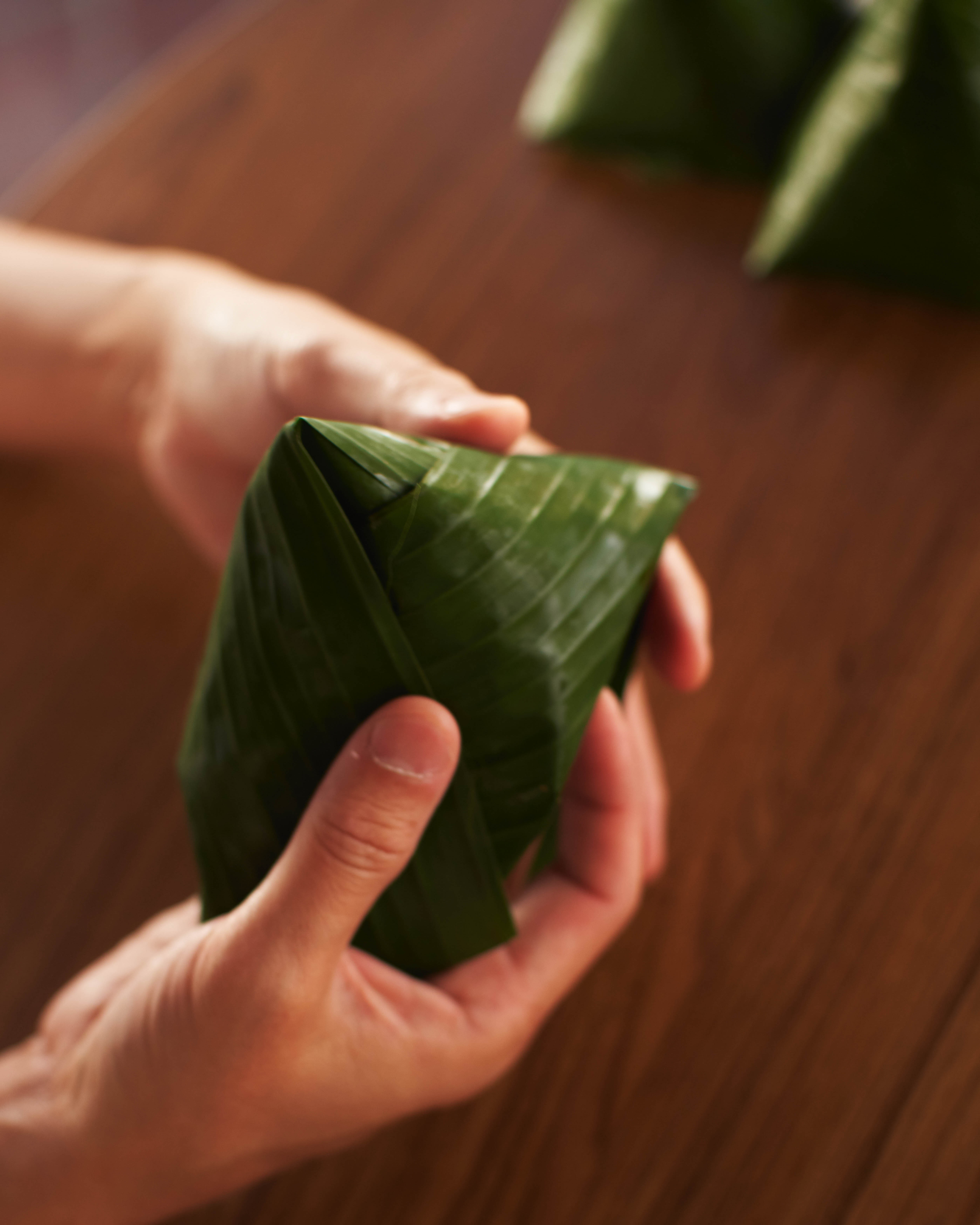


傳統上馬來西亞椰漿飯的食物呈現樸素簡單。為了強調其在國族飲食文化上的特殊代表性,除了椰奶之外,利用芭蕉葉將米飯裹成三角錐飯糰形狀也是特色之一。普通的椰漿飯沒有過多的配菜,除了椰奶香味的白飯之外,再搭配另一個關鍵調味——叁峇辣椒醬,以及黃瓜片和炸得酥脆的鯷魚。於是,當來到馬來西亞,不難發現店家們為了表現各自所售的椰漿飯特色,都會特別在辣椒醬食譜下一番功夫,而且彼此在平衡展現甜、辣、鹹味和口感等元素的辣醬秘方都不盡相同。
椰漿飯在馬來西亞國民心目中的地位類等於臺灣的滷肉飯。除了材料容易取得,其烹煮要求的門檻也不高,使得各家各戶都能夠方便入手,便於廣傳民間;更重要的是,作為國民美食代表,椰漿飯的製作成本不高,它的售價親民也成為不同社會階層人士在日常用餐選擇中的首選。《馬來亞論壇報》(Malaya Tribune) 曾在1946年11月刊登一則題為〈工人的早餐〉(The Worker's Breakfast)的短文。內文提到不同族群在清晨出門工作之前的早餐食物選擇,雖然食譜品項各異,但是共同點在於食物本身售價便宜,也具飽腹感,讓勞力工作者的體力能夠撐到午間用餐時間。其中,椰漿飯被列為馬來族群的早餐首選,形容小小的三角飯糰因便宜又有飽足感而深受歡迎。當然,隨著國民食物地位的逐漸提升,椰漿飯也不再只是馬來族群的代表食物,甚至現在可見這道米食進入高段位餐廳的必選菜單之中,走向精緻化與國際宣傳的消費文化發展方向。除了米飯的配料食材隨之豐富多元,甚至在飯量上也不同於過往傳統三角錐形的小飯糰;不過,也因此展現了椰漿風味白飯之所以能夠代表馬來西亞國民主食,在於它所能允許飲食創意在族群文化詮釋上的彈性展演。
Traditional Malaysian coconut milk rice has a simple presentation. To emphasize its unique role in Malaysian dietary culture, in addition to using coconut milk, nasi lemak is often wrapped in banana leaves to create a triangular-shaped rice ball. Regular nasi lemak doesn’t have many sides; the rich, coconut-flavored rice is usually paired with another key ingredient - sambal (chili paste) as well as sliced cucumber and fried crispy anchovies. As such, nasi lemak vendors in Malaysia will develop exclusive sambal recipes for their business to differentiate their nasi lemak in the market. Sambal recipes, a carefully balanced concoction of sweet, spicy, savory, and different textures, vary drastically in Malaysia.
In Malaysia, nasi lemak is the equivalent of what braised pork rice is to Taiwanese people. The ingredients are easy to acquire, and the culinary skills required are minimal, making it easy for the average person to try it at home and giving rise to its widespread popularity. Most importantly, nasi lemak, often considered the national dish of Malaysia, is relatively inexpensive to make and therefore cheap to consumers, making it the preferred meal for people of different social statuses. In November 1946, the Malaya Tribune published an essay titled “The Worker’s Breakfast,” which discussed different breakfast options of different ethnicities on a regular workday. There were many different breakfast options listed, but all shared the same qualities: they were cheap, filling, and could provide enough energy until lunchtime. The Malaya Tribune listed nasi lemak as the breakfast of choice for the Malay community and described the small triangular rice ball as immensely popular for being cheap and filling. As nasi lemak continues to gain traction as a national dish, it is no longer only representative of the Malay community. Today, we can even see this widespread rice dish in high-end restaurants as it paves its way towards the global market and the world of fine dining. The sides are growing more diverse, and the rice balls are no longer limited to the size or shape of traditional triangular rice balls. The change, however, is a testimony to nasi lemak’s enduring role as the national dish of Malaysia, not for its strict adherence to traditions but for its inclusive nature that enables creativity from various cultures.
店家資訊 Shop Information|
Ali Nasi Lemak Daun Pisang
SEENI MEE SOTONG, Beach St, Georgetown, 10300 George Town, Pulau Pinang
7am–3pm, Sunday Closed
椰漿飯在馬來西亞國民心目中的地位類等於臺灣的滷肉飯。除了材料容易取得,其烹煮要求的門檻也不高,使得各家各戶都能夠方便入手,便於廣傳民間;更重要的是,作為國民美食代表,椰漿飯的製作成本不高,它的售價親民也成為不同社會階層人士在日常用餐選擇中的首選。《馬來亞論壇報》(Malaya Tribune) 曾在1946年11月刊登一則題為〈工人的早餐〉(The Worker's Breakfast)的短文。內文提到不同族群在清晨出門工作之前的早餐食物選擇,雖然食譜品項各異,但是共同點在於食物本身售價便宜,也具飽腹感,讓勞力工作者的體力能夠撐到午間用餐時間。其中,椰漿飯被列為馬來族群的早餐首選,形容小小的三角飯糰因便宜又有飽足感而深受歡迎。當然,隨著國民食物地位的逐漸提升,椰漿飯也不再只是馬來族群的代表食物,甚至現在可見這道米食進入高段位餐廳的必選菜單之中,走向精緻化與國際宣傳的消費文化發展方向。除了米飯的配料食材隨之豐富多元,甚至在飯量上也不同於過往傳統三角錐形的小飯糰;不過,也因此展現了椰漿風味白飯之所以能夠代表馬來西亞國民主食,在於它所能允許飲食創意在族群文化詮釋上的彈性展演。
Traditional Malaysian coconut milk rice has a simple presentation. To emphasize its unique role in Malaysian dietary culture, in addition to using coconut milk, nasi lemak is often wrapped in banana leaves to create a triangular-shaped rice ball. Regular nasi lemak doesn’t have many sides; the rich, coconut-flavored rice is usually paired with another key ingredient - sambal (chili paste) as well as sliced cucumber and fried crispy anchovies. As such, nasi lemak vendors in Malaysia will develop exclusive sambal recipes for their business to differentiate their nasi lemak in the market. Sambal recipes, a carefully balanced concoction of sweet, spicy, savory, and different textures, vary drastically in Malaysia.
In Malaysia, nasi lemak is the equivalent of what braised pork rice is to Taiwanese people. The ingredients are easy to acquire, and the culinary skills required are minimal, making it easy for the average person to try it at home and giving rise to its widespread popularity. Most importantly, nasi lemak, often considered the national dish of Malaysia, is relatively inexpensive to make and therefore cheap to consumers, making it the preferred meal for people of different social statuses. In November 1946, the Malaya Tribune published an essay titled “The Worker’s Breakfast,” which discussed different breakfast options of different ethnicities on a regular workday. There were many different breakfast options listed, but all shared the same qualities: they were cheap, filling, and could provide enough energy until lunchtime. The Malaya Tribune listed nasi lemak as the breakfast of choice for the Malay community and described the small triangular rice ball as immensely popular for being cheap and filling. As nasi lemak continues to gain traction as a national dish, it is no longer only representative of the Malay community. Today, we can even see this widespread rice dish in high-end restaurants as it paves its way towards the global market and the world of fine dining. The sides are growing more diverse, and the rice balls are no longer limited to the size or shape of traditional triangular rice balls. The change, however, is a testimony to nasi lemak’s enduring role as the national dish of Malaysia, not for its strict adherence to traditions but for its inclusive nature that enables creativity from various cultures.
Ali Nasi Lemak Daun Pisang
SEENI MEE SOTONG, Beach St, Georgetown, 10300 George Town, Pulau Pinang
7am–3pm, Sunday Closed


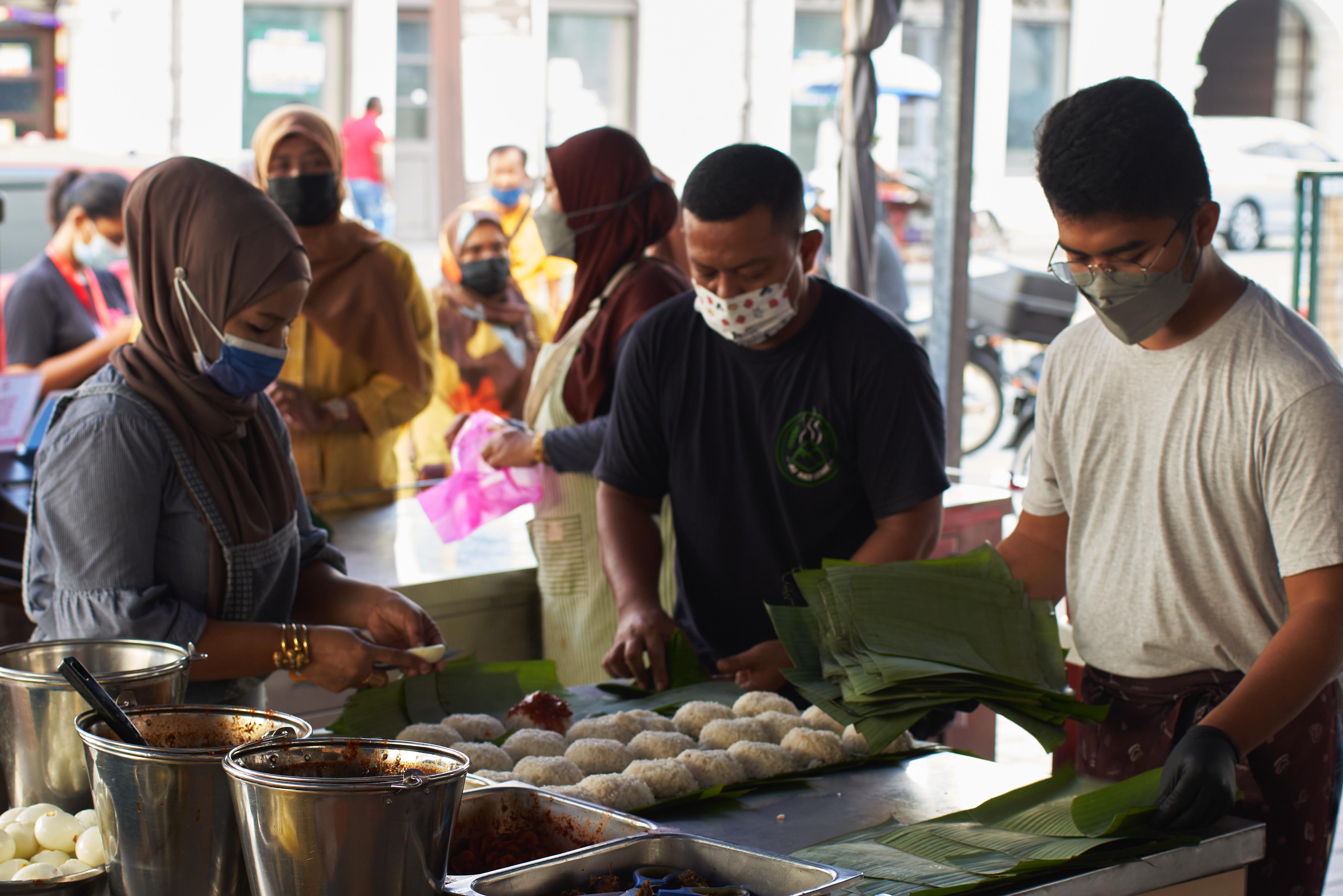
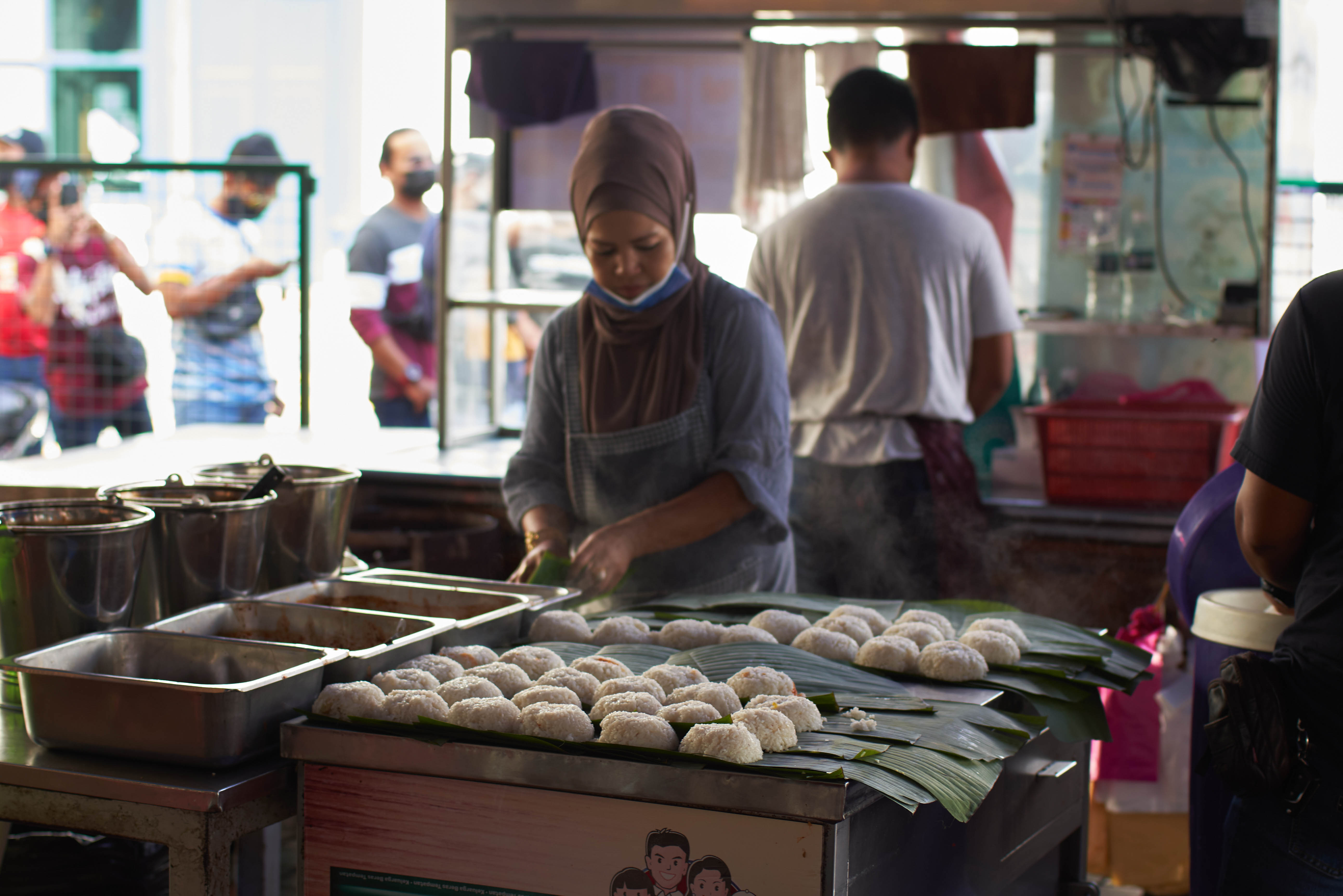

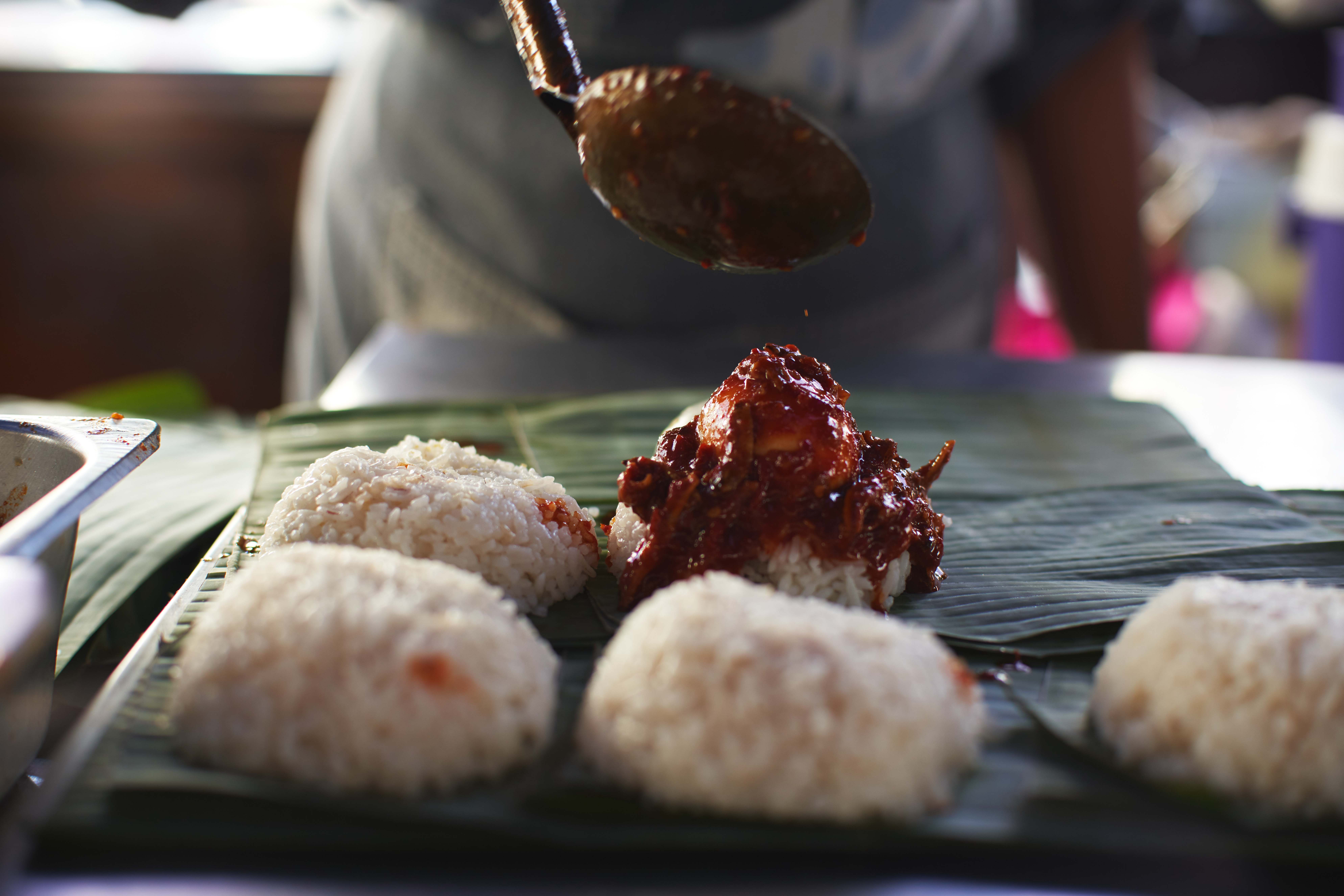
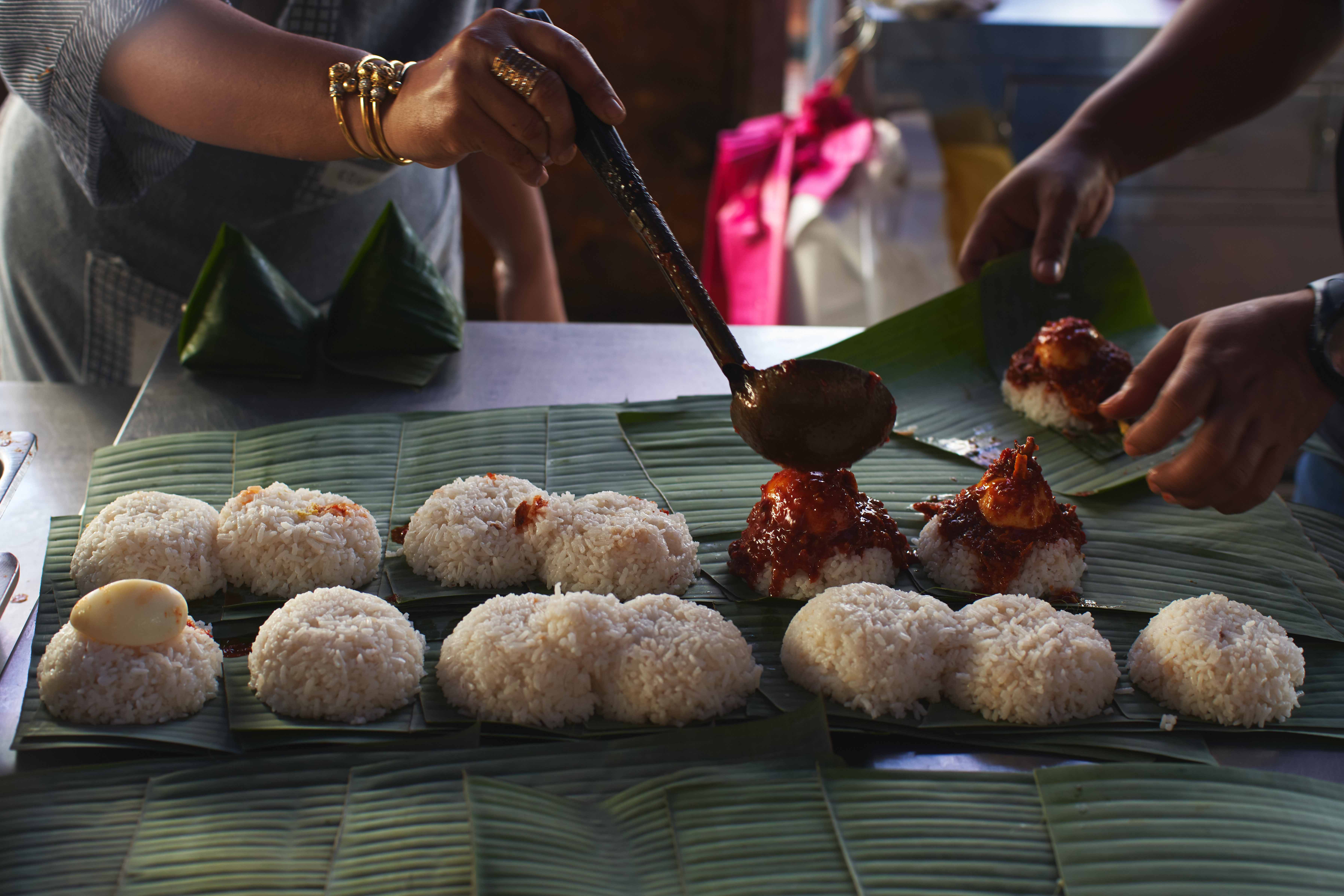

扁擔飯 Nasi Kandar
走在檳城街道上,不難看到店外擺放著標誌性銀白色鋁製餐桌椅子的「嘛嘛檔」(Mamak stall),其普遍程度不亞於在臺北街頭出現的早餐店。「嘛嘛」一詞源自於印度南部泰米爾人(Tamil)對母系男性親屬的「舅舅」(maa-ma)稱謂。馬來西亞人最爲熟悉的嘛嘛檔即為由一群印度裔穆斯林男性所經營的街頭餐飲店。因此,嘛嘛也逐漸成爲印度裔穆斯林店員的地方化通稱代詞。説到嘛嘛檔的招牌食物,必定會想到扁擔飯(nasi Kandar)。該米食僅是普通的白飯,並無特別經過調味處理;反而在食物呈現上可以想象成臺灣便當與燴飯的類綜合體。扁擔飯最爲關鍵的靈魂就是在白飯淋上各種不同味道的醬汁。這些醬汁可以是不同辣度的咖喱,也有不辣的肉醬,搭配上經典的配菜如炒高麗菜、海鮮和腌料炸鷄等。
扁擔飯的命名以及混合醬汁的食用方式是有它特殊的族群遷徙歷史。19世紀時期的東南亞地區盛行茶葉和橡膠園等種植活動,因此殖民政府因經濟生產需求而從印度跨洋遠渡一批勞力工作者。以當時仍處於英國殖民時期的馬來亞爲例,最初從印度引入罪犯勞工,而後從契約勞工制(indentured labour)和凱加耐工頭系統(Kangani system)不斷招募來自南印度的勞工,其中以泰米爾穆斯林社群的人數最多。這些離鄉背井的人在下船後一開始聚集在碼頭一帶,等待被分發委派到其他園地工作。爲了解決溫飽和安頓生計,開始有人在碼頭區域販售米飯。挑著扁擔沿路販售的方式也便利這些勞工小販自由移動,久而久之以扁擔飯作統稱。扁擔一側裝著米飯,另一側則裝著咖喱醬汁和配菜;裝盤的方式就直接將醬汁淋在白飯上遞給客人。早期的碼頭工人習慣在一大早上工之前,先來一餐白飯米食填飽肚子,因此扁擔飯在早上就已經開始販賣。至今,大部分的嘛嘛檔也常見在早上備好醬料配菜開始營業。
早期的扁擔飯主要客群為勞力工作者,因此價格實惠;然而現今的扁擔飯不僅出現在街頭,也售於高價位餐廳,配菜選擇也變得更多元豐富和精緻化,使得有些扁擔飯走出平價等級。如今一般説法認爲檳城是印度裔穆斯林的扁擔飯的起源地,因爲該城市臨海有碼頭,也是早期航海貿易的重要交集點。對於扁擔飯是否發跡於檳城,或許無法在此進一步考究,但無可否認,扁擔飯背後蘊含的族群歷史,造就了如今龐大的飲食消費文化和客群,成爲馬來半島街頭上另一個經典的米食景象。


Nasi Kandar
Walking on the streets of Penang, it would be hard to miss the many mamak stalls, characterized by their signature aluminum chairs, as the prevalence of mamak stalls in Penang is akin to breakfast stalls in Taipei. The term mamak originates from the Tamil (of southern India) term for maternal uncle, or “maa-ma” and the mamak stalls that Malaysians are so familiar with are usually run by Indian Muslim men. As such, mamak has now become an umbrella term for all Indian Muslim shopkeepers in Malaysia. When it comes to the food, nasi kandar is the undeniable signature dish of mamak stalls. Nasi kandar consists of plain white rice without additional flavoring or spices and is rather like a combination of Taiwanese bento and rice bowls topped with a braised sauce. The heart and soul of a nasi kandar dish are the different sauces drizzled over the rice, which could be curry of varying levels of spiciness and non-spicy braised meat sauces. The rice with sauce would then be complemented by classic sides such as stir-fried cabbage, seafood, fried chicken, etc.
The name nasi kandar and the unique way it’s served, with curry or gravy drizzled on top, is the product of human migration. In the 19th Century, tea and rubber plantations were common in Southeast Asia. To meet labor demands in colonies for economic production, the British colonial government facilitated the migration of Indian workers. Malaysia, at the time under British colonization, introduced penal labor from India at first and then continued to recruit laborers from southern India through indentured labor and the Kangani system. Tamil Muslims were the largest community to have migrated from southern India to Malaysia for work, and they would congregate at the marinas after arrival, waiting to be dispatched to plantations. For their livelihood and for food, many started to make and sell rice near the marinas, carrying kandars (shoulder poles) with the food to walk around, giving nasi kandar its name. On one side of the kandar would be rice, and on the other side, curry, sauce, and sides. The vendor would pour either curry or meat sauces onto the rice for serving. Marina workers of the past became accustomed to filling their bellies with a bowl of rice in the early mornings before they even started work, and so nasi kandar vendors started their days in the early mornings as well. To this day, the majority of mamak stalls will also prepare curries, sauces, and sides early in the morning for the breakfast crowd.
The earliest diners of nasi kandar were laborers, and so the dish was naturally very affordable. Nowadays, we can find nasi kandar in the streets but also in high-end restaurants with more diverse, extravagant sides and, of course, higher prices. One of the most commonly accepted origin stories points to Penang as the birthplace of Tamil Muslim nasi kandar because of the city’s marinas and status as an important hub for maritime trade in the 19th Century. Whether Penang is truly the birthplace of nasi kandar will perhaps be a question that can never be answered with utmost certainty, but it is undeniable that nasi kandar’s underlying history of ethnicity has given rise to such a massive dietary culture, consumer culture, and consumer base. Nasi kandar is now another classic rice landscape on the streets of the Malay Peninsula.



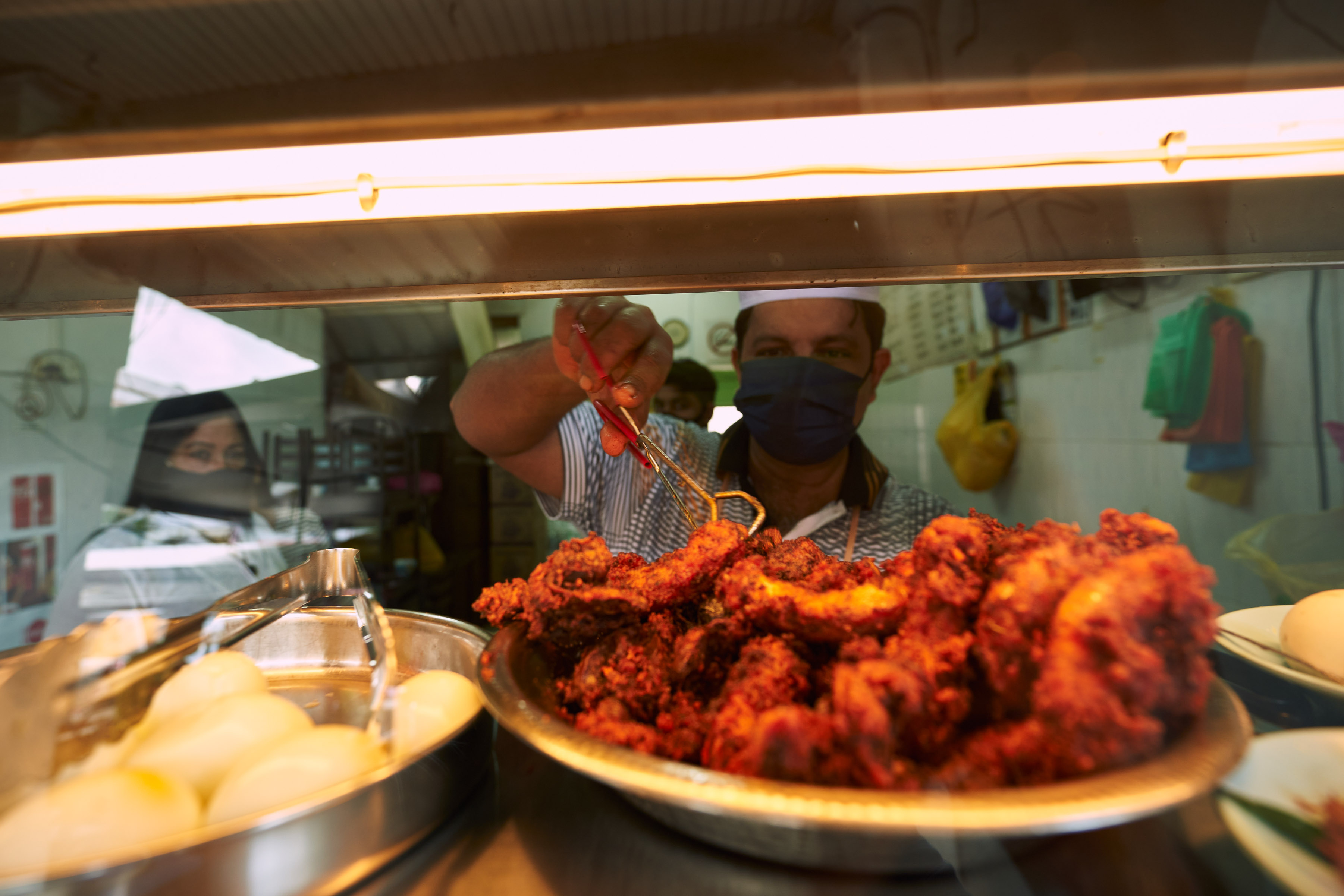
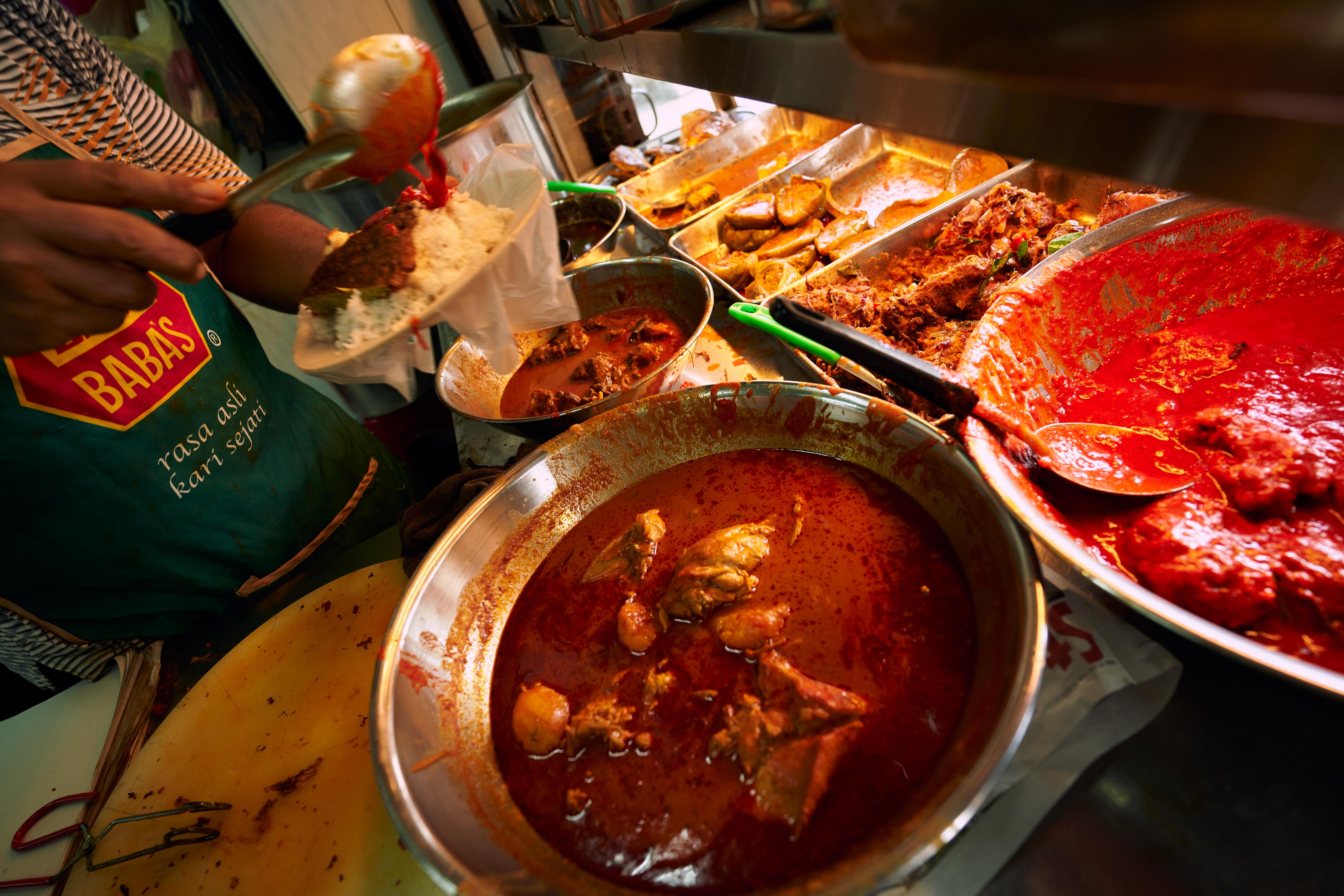
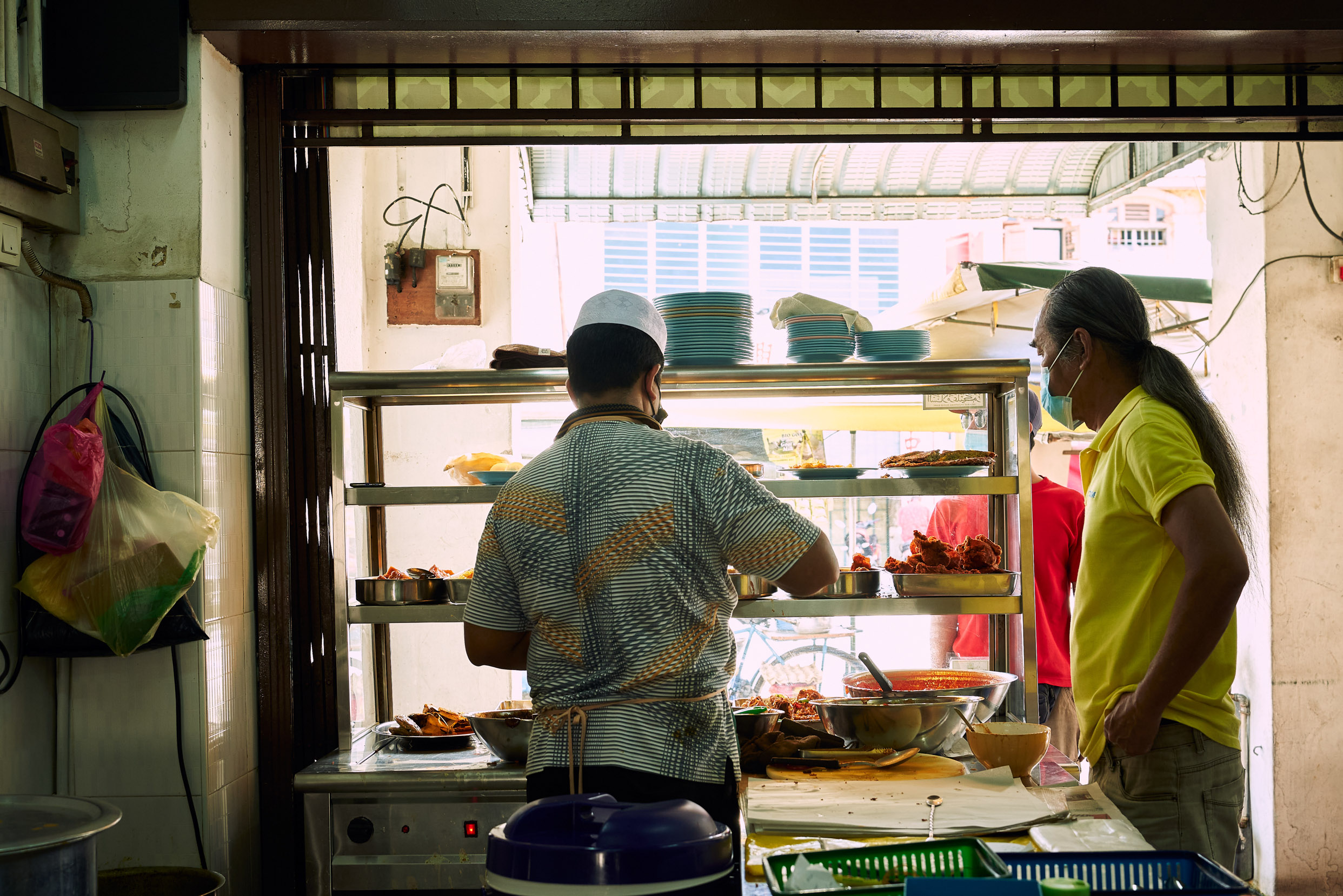
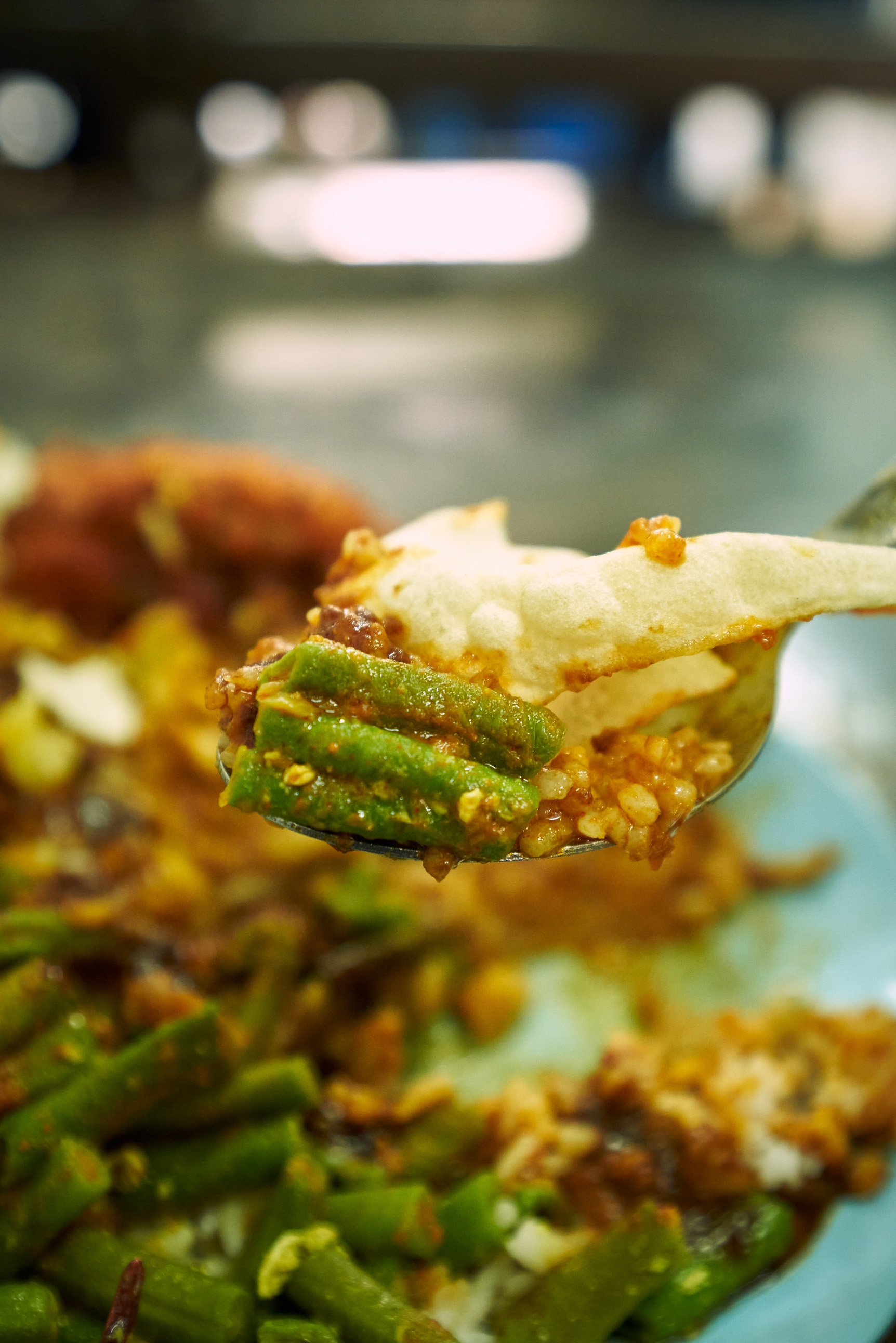
竹筒飯(Lemang)
米飯配著叁峇辣椒醬吃 Makan nasi dengan sambal
吃得像猿猴一樣慢 Makan perlahan macam siamang
對自己定性別過於自信 Jangan ingat anda kebal
竹筒飯一上桌會讓你破功 Bila atas meja ada lemang
Rice paired with sambal.
Eating as slow as an ape.
Don’t trust your self-control too much,
with lemang on the table, you will lose control.

以上這首馬來班頓詩(pantun),主要在後半段兩句呈現竹筒飯(lemang)在馬來人飲食文化中的重要性。Lemang不僅是食物名稱,也意指以竹子為容器來烹煮米飯的方式。竹筒飯被認為象徵歡騰氣氛與社會之間的和諧關係,原因在於準備這道米食的過程不易,需要眾人的分工合作才能妥善備料與精準地掌握熟食時機。
目前可見的竹筒飯有兩種煮法,通稱為傳統竹燒和機器燜燒。兩者之間的共同點在於將米粒以圓柱形容器包覆著再放在火源上燒烤至煮熟。傳統竹燒顧名思義,以竹子作為容器來燒製,並且以柴火而非瓦斯爐來作為火源。傳統竹燒方法有兩種燒法,除了直觀地將竹筒放在火堆中燒烤,還有一種是利用架子撐起竹筒圓柱再以煙燻方式慢製熟成。馬來半島某些鄉鎮常見攤商在路邊立起長型木架(langgai),並將裝著生米的竹筒放在木架上煙燻。這兩種燒法都需要人力在一旁不斷觀察火勢,根據竹筒外層的燻黑與冒煙程度來判斷竹筒換邊的時機,以便米飯在容器裡皆可均勻受熱,也避免某個部位過度燒焦。傳統竹燒的方式因為耗時長也需要人力,因此為了迎合市面量產的需求,馬來西亞農業發展研究所(MARDI)特製研發了一種防鏽的鋼材圓筒來取代傳統的竹筒,透過鋼材透熱的特性來縮短米飯煮熟的所需時間。傳統竹燒至少需要四至六個小時,但鋼筒的替代可將米飯控制在兩小時內熟成。
The pantun (Malay oral poem) above shows the importance of lemang (rice bamboo) in the Malay diet. Lemang is not only the name of this dish but also refers to the technique of cooking rice in bamboo. The dish is often recognized as a symbol of jubilation and peaceful society as lemang requires complicated processes and a group of people working to prep materials and cook the rice and sides in tandem to guarantee ideal timing.
In the present day, lemang can be cooked in two ways: with bamboo or modern machines. For both methods, you have to pour rice into a cylindrical container and then roast it over an open flame until the rice is cooked. The traditional way, with bamboo, is rather self-explanatory: the bamboo serves as the cylindrical container that will be roasted in the fire pit or placed on a rack to be thoroughly smoked through. In some villages of the Malay Peninsula, we can often see vendors putting up langgai (long wooden racks) on the side of the streets and then placing rice-filled bamboo onto the langgai for smoking. Both techniques require someone to tend to the fire constantly and determine when to flip the bamboo according to charring and the smoke for even heating and to prevent scorching the bamboo. The traditional bamboo approach has a long cooking time and requires constant care. To meet demands for massive production, the Malaysian Agricultural Research and Development Institute has developed a special anti-rusting steel cylinder to replace traditional bamboo tubes. The steel is better at conducting heat and can reduce the time it takes to cook the rice. While cooking in bamboo takes at least four to six hours, the steel cylinders can produce cooked rice in just two hours.
目前可見的竹筒飯有兩種煮法,通稱為傳統竹燒和機器燜燒。兩者之間的共同點在於將米粒以圓柱形容器包覆著再放在火源上燒烤至煮熟。傳統竹燒顧名思義,以竹子作為容器來燒製,並且以柴火而非瓦斯爐來作為火源。傳統竹燒方法有兩種燒法,除了直觀地將竹筒放在火堆中燒烤,還有一種是利用架子撐起竹筒圓柱再以煙燻方式慢製熟成。馬來半島某些鄉鎮常見攤商在路邊立起長型木架(langgai),並將裝著生米的竹筒放在木架上煙燻。這兩種燒法都需要人力在一旁不斷觀察火勢,根據竹筒外層的燻黑與冒煙程度來判斷竹筒換邊的時機,以便米飯在容器裡皆可均勻受熱,也避免某個部位過度燒焦。傳統竹燒的方式因為耗時長也需要人力,因此為了迎合市面量產的需求,馬來西亞農業發展研究所(MARDI)特製研發了一種防鏽的鋼材圓筒來取代傳統的竹筒,透過鋼材透熱的特性來縮短米飯煮熟的所需時間。傳統竹燒至少需要四至六個小時,但鋼筒的替代可將米飯控制在兩小時內熟成。
The pantun (Malay oral poem) above shows the importance of lemang (rice bamboo) in the Malay diet. Lemang is not only the name of this dish but also refers to the technique of cooking rice in bamboo. The dish is often recognized as a symbol of jubilation and peaceful society as lemang requires complicated processes and a group of people working to prep materials and cook the rice and sides in tandem to guarantee ideal timing.
In the present day, lemang can be cooked in two ways: with bamboo or modern machines. For both methods, you have to pour rice into a cylindrical container and then roast it over an open flame until the rice is cooked. The traditional way, with bamboo, is rather self-explanatory: the bamboo serves as the cylindrical container that will be roasted in the fire pit or placed on a rack to be thoroughly smoked through. In some villages of the Malay Peninsula, we can often see vendors putting up langgai (long wooden racks) on the side of the streets and then placing rice-filled bamboo onto the langgai for smoking. Both techniques require someone to tend to the fire constantly and determine when to flip the bamboo according to charring and the smoke for even heating and to prevent scorching the bamboo. The traditional bamboo approach has a long cooking time and requires constant care. To meet demands for massive production, the Malaysian Agricultural Research and Development Institute has developed a special anti-rusting steel cylinder to replace traditional bamboo tubes. The steel is better at conducting heat and can reduce the time it takes to cook the rice. While cooking in bamboo takes at least four to six hours, the steel cylinders can produce cooked rice in just two hours.
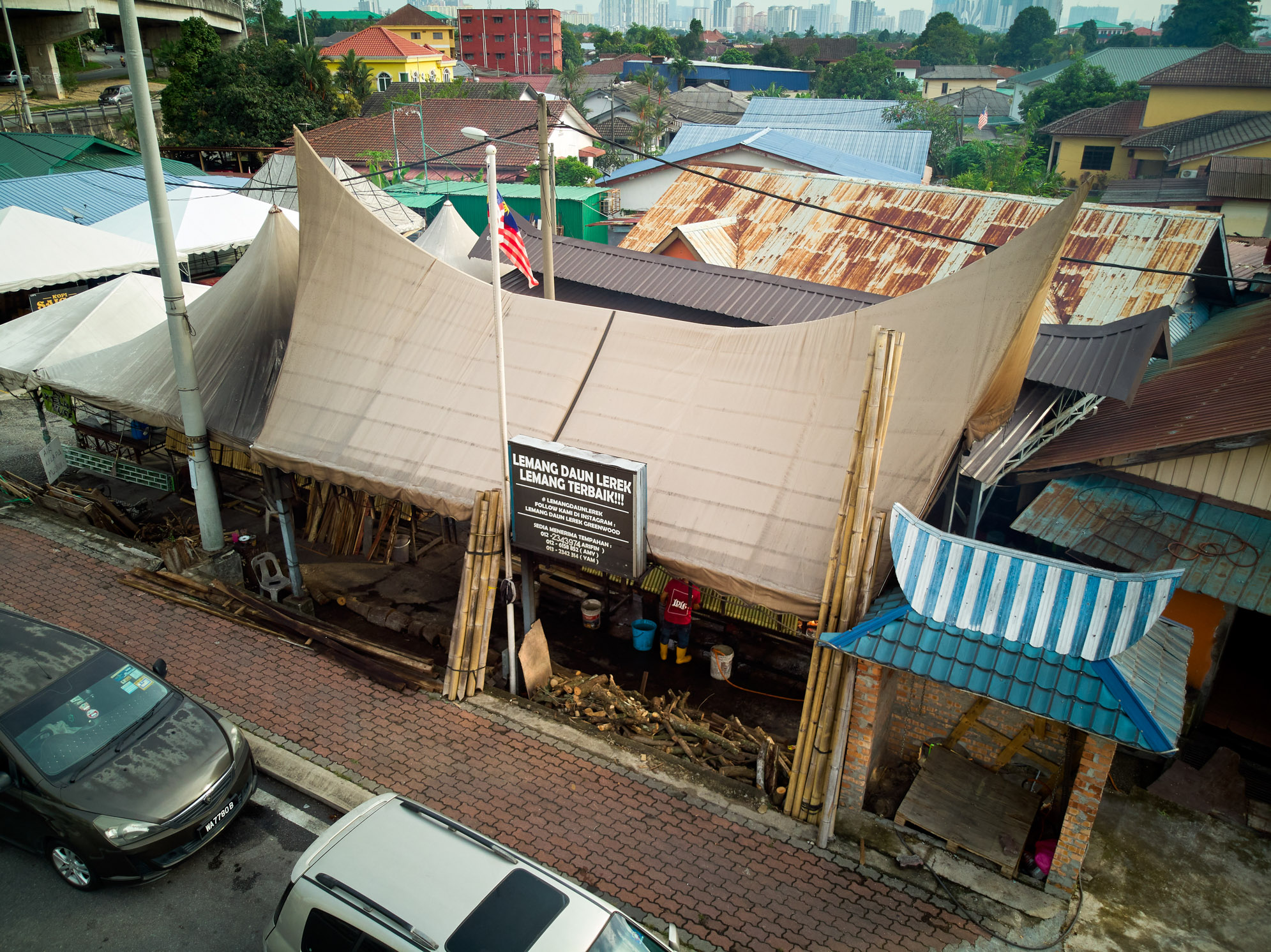


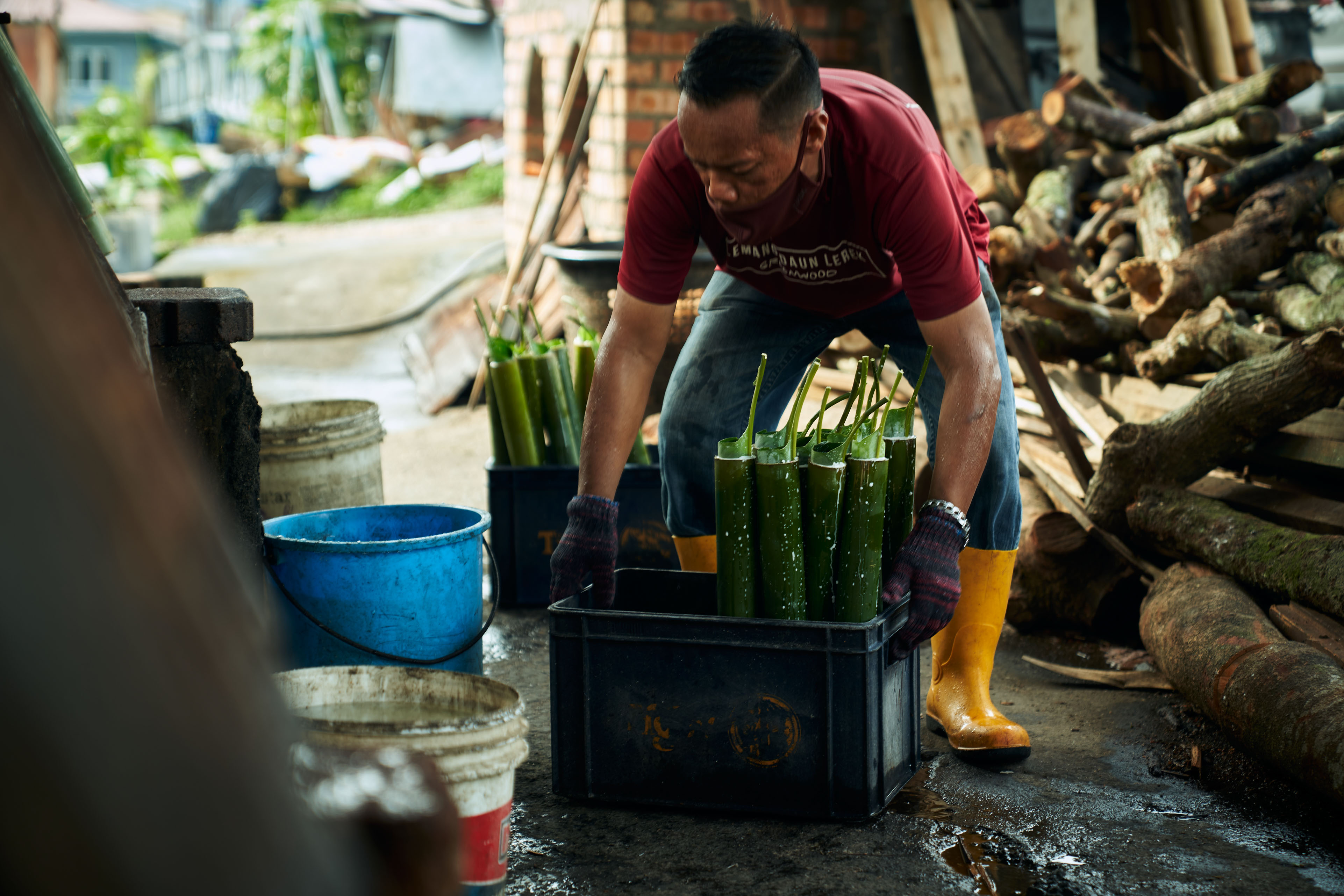
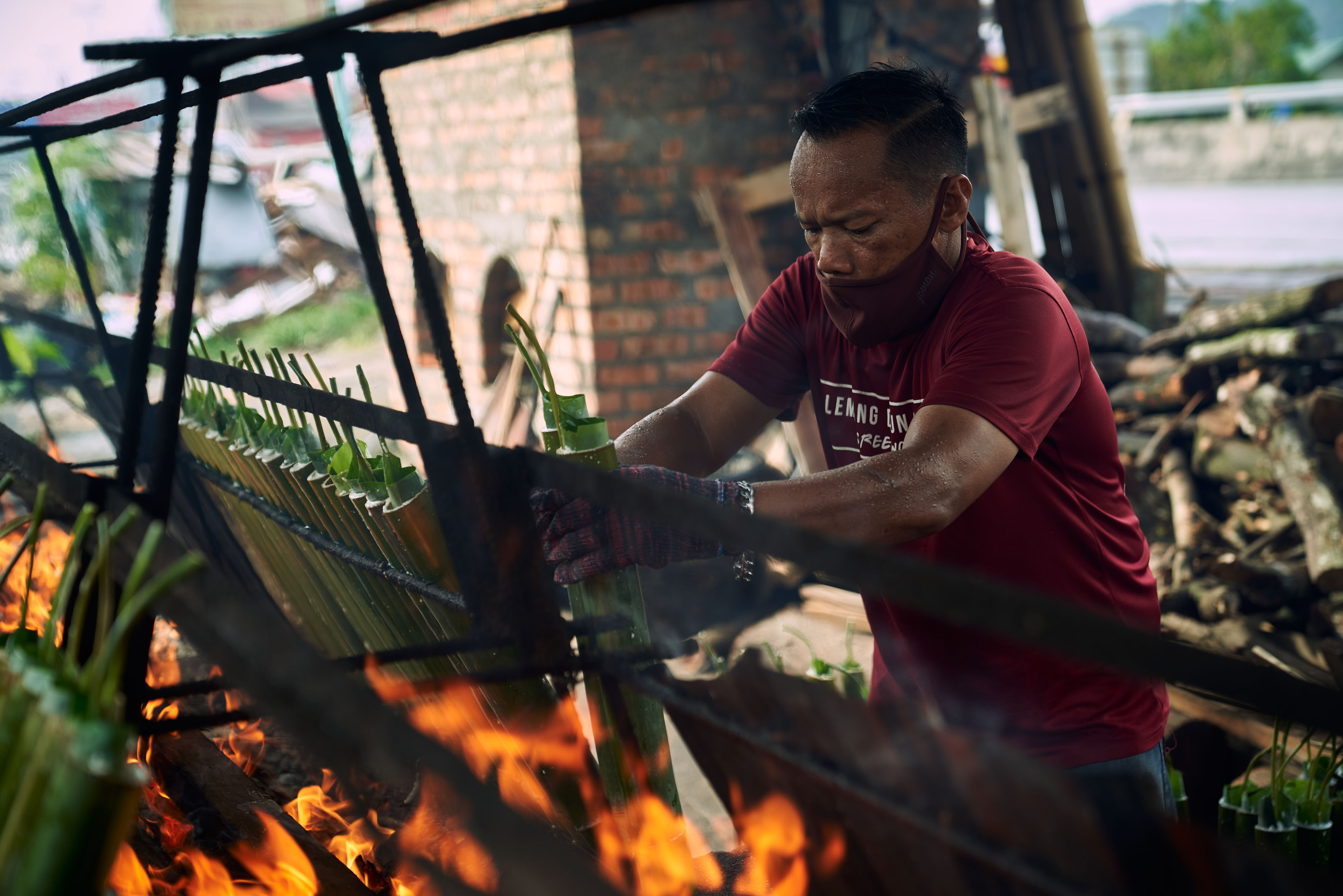
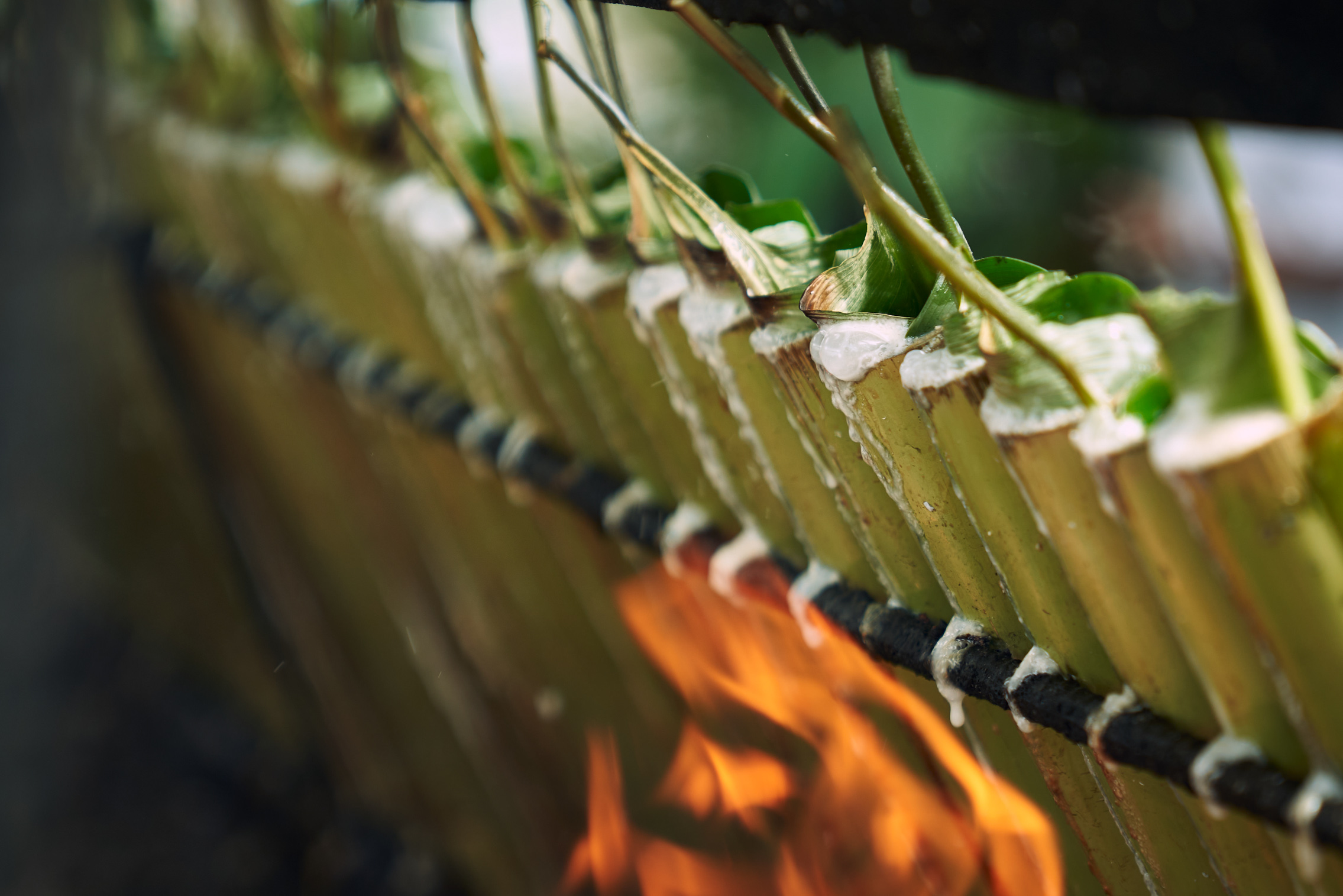



然而有些食客認為傳統竹燒的米飯才是正宗的竹筒飯,因為市面上開始出現仿製的竹筒飯。這類所謂假的竹筒飯,一般是指業者先利用普通電飯鍋將米飯煮熟,再將飯塞進另外準備好的竹筒容器中。由於竹子材料不易取得,所以業者們在販售米飯時,會將竹筒回收藏起,循環利用。但是這些二手竹筒不再有原先特殊的香氣,使得「假的竹筒飯」缺乏食客所追求的竹香風味。此外,竹筒飯的香味也部分來自於柴火燒炭的煙燻味,以及竹筒內部另鋪上一層的芭蕉葉片,缺一不可。不僅在風味上,真正使用竹子和柴火來燒製的竹筒飯也可從米飯的表面觸感來作辨別。傳統竹燒的米飯其上下末端兩段會比較鬆軟,最適合入口的部位在於竹筒中段的米飯。反而一般飯鍋煮成的後製加工竹筒飯其表面會較為平滑,缺少水氣燜在竹筒內部受熱蒸發留下的坑洞外觀。
竹子選材本身也是一門學問,並非任何一種品種都適合用來燒製竹筒飯。竹筒飯的理想竹材是來自分佈於亞洲熱帶地區的烏魯竹(Schizostachyum zollingeri Steud.)。該竹子品種居多長在鮮有人類活動痕跡的偏遠地區。之所以後來被運用在米飯烹煮上,這與竹子本身的質地和人類活動需求有關。相較於其他品種的竹子,竹壁較薄且竹筒較為空洞的烏魯竹不符合當時人類社會對於堅固建材的要求,因此常被忽略在野外。然而竹子不耐風吹雨打,經常成群大片倒在荒野。直到長途跋涉的旅人因需要臨時尋找容器煮食,遇到一堆垮倒在叢林的烏魯竹,才衍生出利用這類竹子煮米飯的飲食經濟價值。
竹筒飯之所以能夠流通於民間,不僅是竹子本身的香氣風味,更重要的是米飯經過竹筒內壁的燜燒製法而得以久耐存放、不易變質發酸,以及竹筒適合作為米飯的容器讓旅人隨身攜帶遠行。
With a rising number of pseudo lemangs appearing on the market, many epicureans strongly believe that only rice cooked in bamboo can be considered authentic lemang. The so-called fake lemangs are cooked in regular rice cookers and then stuffed into bamboo. As bamboo is difficult to acquire, many vendors will keep the bamboo when selling lemang to use again and again. The recycled bamboo no longer retains its unique fragrance, and so “fake lemang” lacks the bamboo aroma that epicureans lust after. The burning wood that lemang is roasted in or above and the banana leaf lining the inside of the bamboo also contributes to lemang’s distinct flavor. It’s not just the flavor, either. True lemang lovers can also tell whether the lemang is authentic or fake just by feeling the surface of the rice. Authentic lemang will have softer, fluffier rice on both ends of the bamboo, and the best part would be the rice at the center of the bamboo. Fake lemangs that are simply cooked rice stuffed in bamboo will have a smooth surface and lack the lumpy surface from steam evaporating with the bamboo.
Choosing the right bamboo is also an art in and of itself; not all bamboo species are made for lemang. The most ideal bamboo for lemang is the schizostachyum zollingeri, an evergreen bamboo found in the tropical regions of Asia. Commonly found in remote areas with little human activities, the schizostachyum zollingeri bamboo has been used for cooking rice because the culm wall is too thin and the culm too hollow for building houses. Often left to its own devices, the schizostachyum zollingeri topples from fierce winds and can frequently be found simply lying around en masse in the wild until travelers seeking cooking vessels stumbled across the bamboo one day and started using the bamboo for cooking rice, thereby imbuing it with economic value.
The widespread popularity of rice bamboo among the people can be attributed to the natural bamboo aroma and, more importantly, lemang’s portability and stable shelf life from the way the rice is steamed within the culm make it the perfect food for travelers.
店家資訊 Shop Information|
Lemang Daun Lerek Greenwood
Jalan Batu Caves, Kampung Tengah Lembah Gombak, 68100 Batu Caves, Selangor
Sunday, 8am–10pm
竹子選材本身也是一門學問,並非任何一種品種都適合用來燒製竹筒飯。竹筒飯的理想竹材是來自分佈於亞洲熱帶地區的烏魯竹(Schizostachyum zollingeri Steud.)。該竹子品種居多長在鮮有人類活動痕跡的偏遠地區。之所以後來被運用在米飯烹煮上,這與竹子本身的質地和人類活動需求有關。相較於其他品種的竹子,竹壁較薄且竹筒較為空洞的烏魯竹不符合當時人類社會對於堅固建材的要求,因此常被忽略在野外。然而竹子不耐風吹雨打,經常成群大片倒在荒野。直到長途跋涉的旅人因需要臨時尋找容器煮食,遇到一堆垮倒在叢林的烏魯竹,才衍生出利用這類竹子煮米飯的飲食經濟價值。
竹筒飯之所以能夠流通於民間,不僅是竹子本身的香氣風味,更重要的是米飯經過竹筒內壁的燜燒製法而得以久耐存放、不易變質發酸,以及竹筒適合作為米飯的容器讓旅人隨身攜帶遠行。
With a rising number of pseudo lemangs appearing on the market, many epicureans strongly believe that only rice cooked in bamboo can be considered authentic lemang. The so-called fake lemangs are cooked in regular rice cookers and then stuffed into bamboo. As bamboo is difficult to acquire, many vendors will keep the bamboo when selling lemang to use again and again. The recycled bamboo no longer retains its unique fragrance, and so “fake lemang” lacks the bamboo aroma that epicureans lust after. The burning wood that lemang is roasted in or above and the banana leaf lining the inside of the bamboo also contributes to lemang’s distinct flavor. It’s not just the flavor, either. True lemang lovers can also tell whether the lemang is authentic or fake just by feeling the surface of the rice. Authentic lemang will have softer, fluffier rice on both ends of the bamboo, and the best part would be the rice at the center of the bamboo. Fake lemangs that are simply cooked rice stuffed in bamboo will have a smooth surface and lack the lumpy surface from steam evaporating with the bamboo.
Choosing the right bamboo is also an art in and of itself; not all bamboo species are made for lemang. The most ideal bamboo for lemang is the schizostachyum zollingeri, an evergreen bamboo found in the tropical regions of Asia. Commonly found in remote areas with little human activities, the schizostachyum zollingeri bamboo has been used for cooking rice because the culm wall is too thin and the culm too hollow for building houses. Often left to its own devices, the schizostachyum zollingeri topples from fierce winds and can frequently be found simply lying around en masse in the wild until travelers seeking cooking vessels stumbled across the bamboo one day and started using the bamboo for cooking rice, thereby imbuing it with economic value.
The widespread popularity of rice bamboo among the people can be attributed to the natural bamboo aroma and, more importantly, lemang’s portability and stable shelf life from the way the rice is steamed within the culm make it the perfect food for travelers.
Lemang Daun Lerek Greenwood
Jalan Batu Caves, Kampung Tengah Lembah Gombak, 68100 Batu Caves, Selangor
Sunday, 8am–10pm
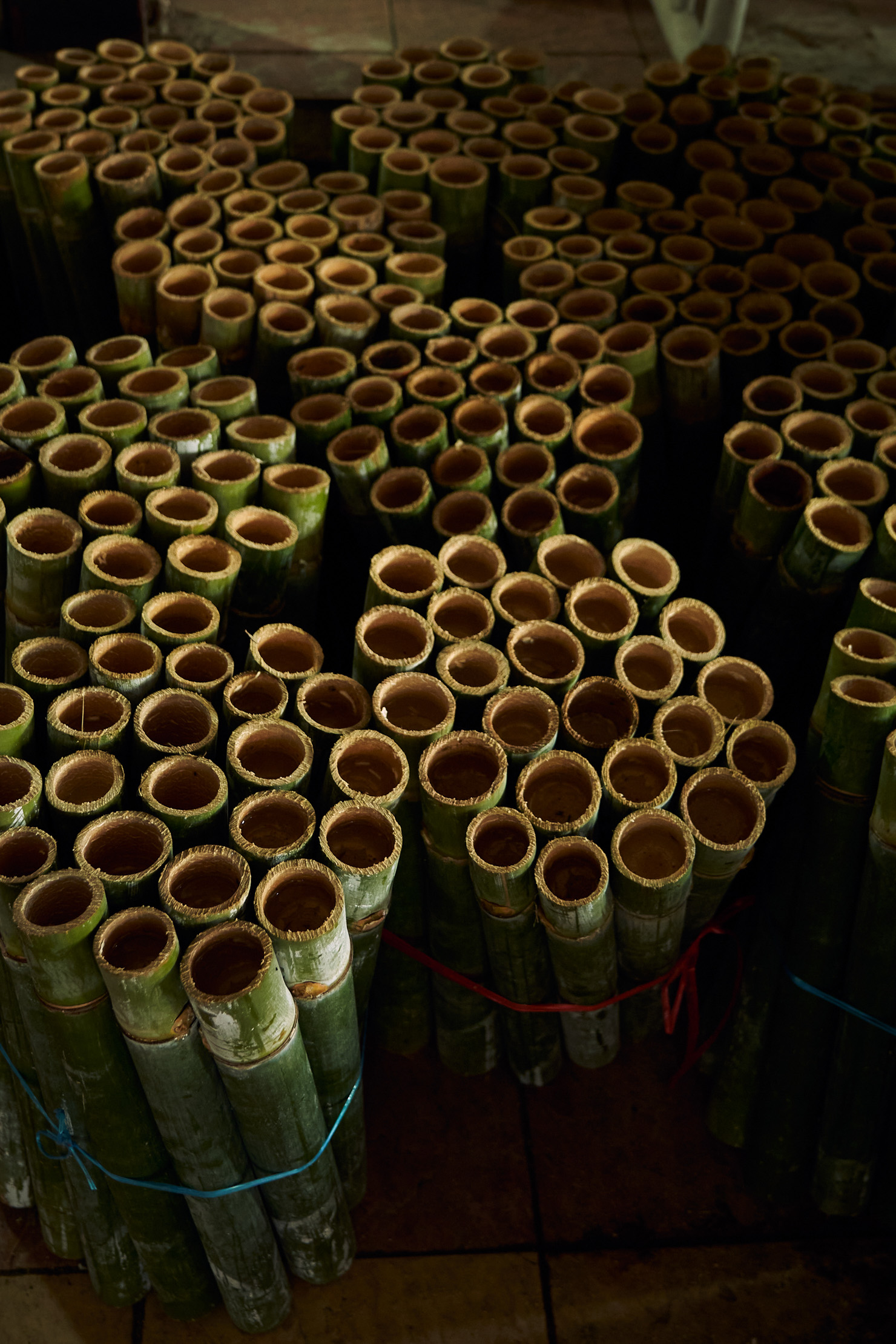

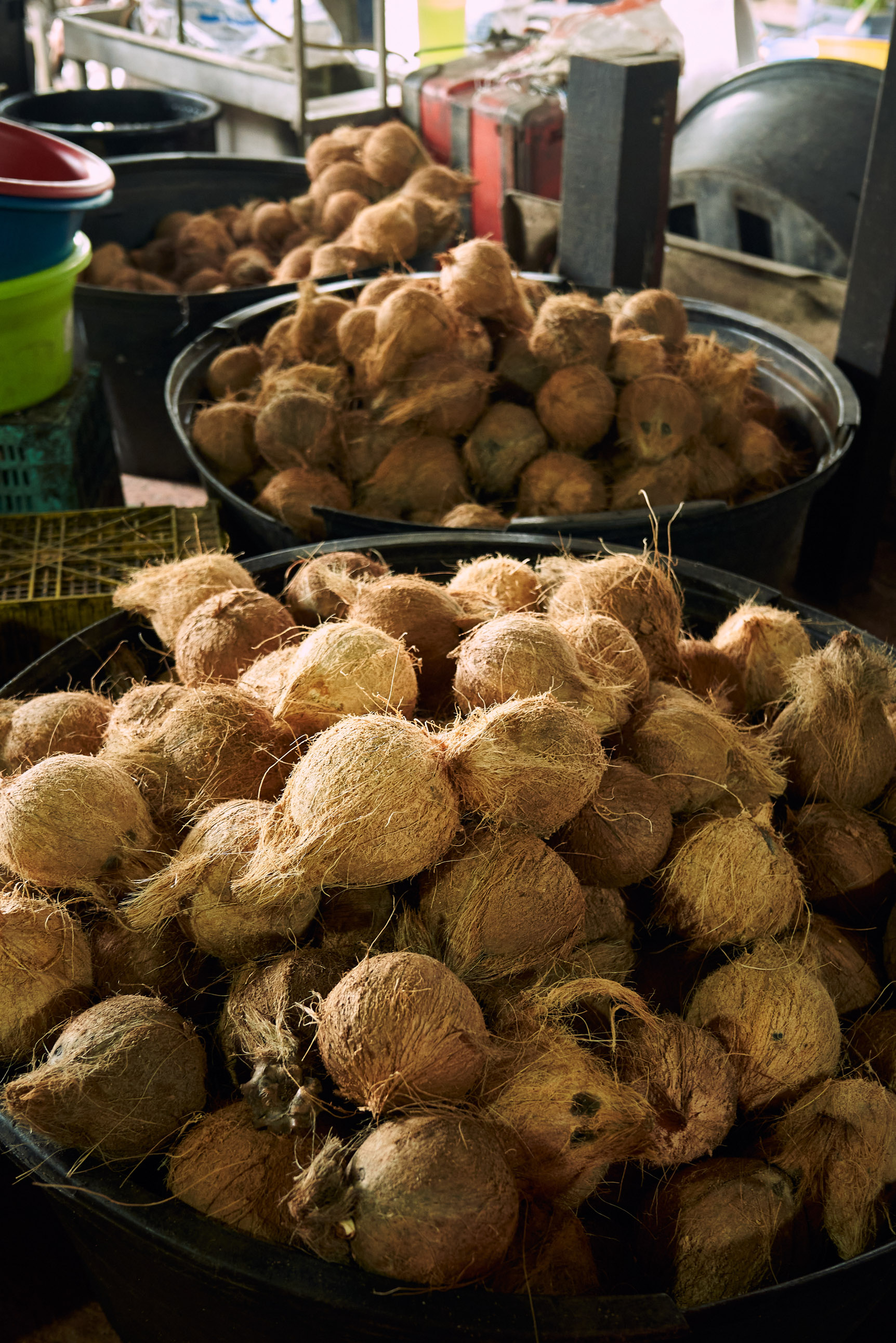

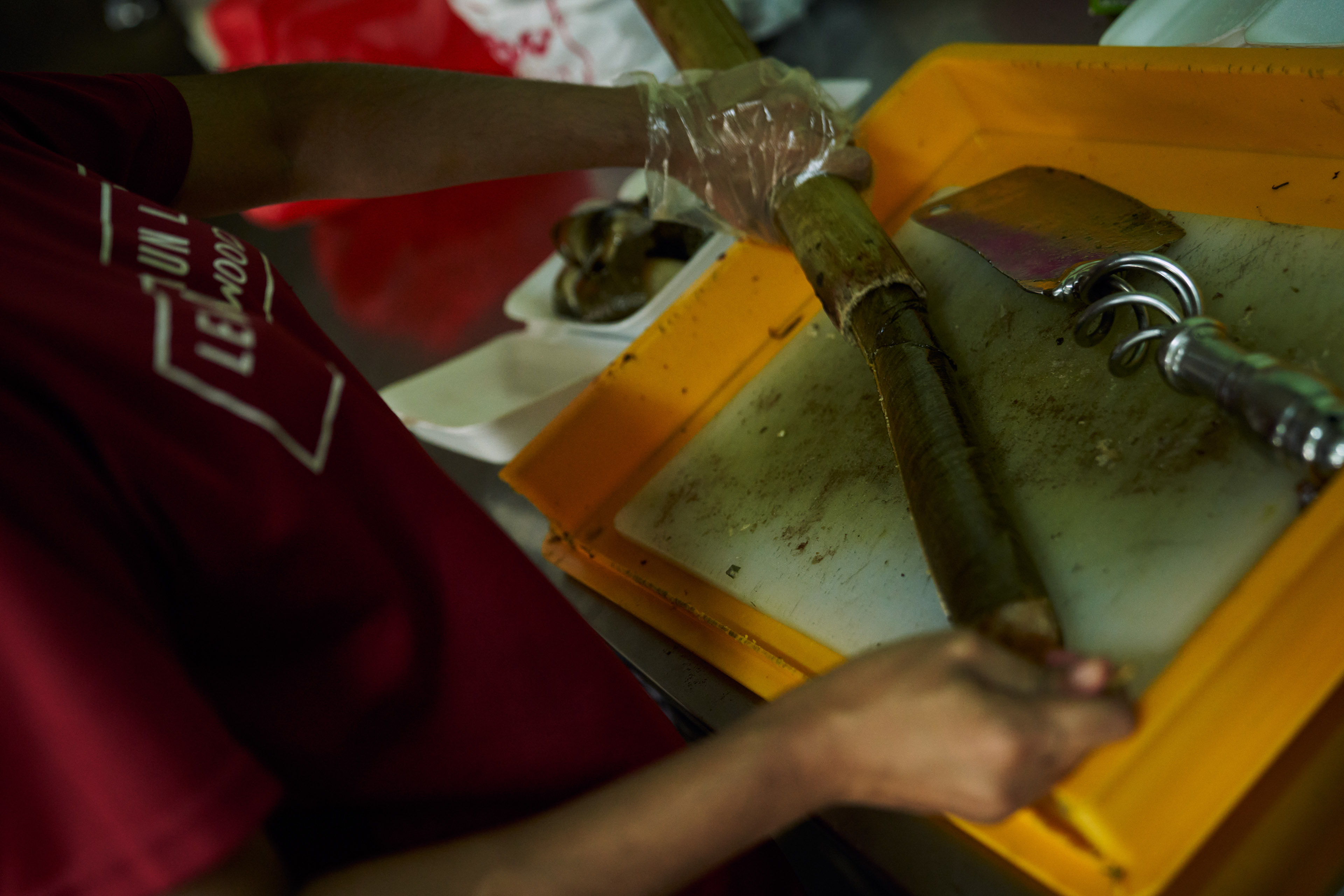
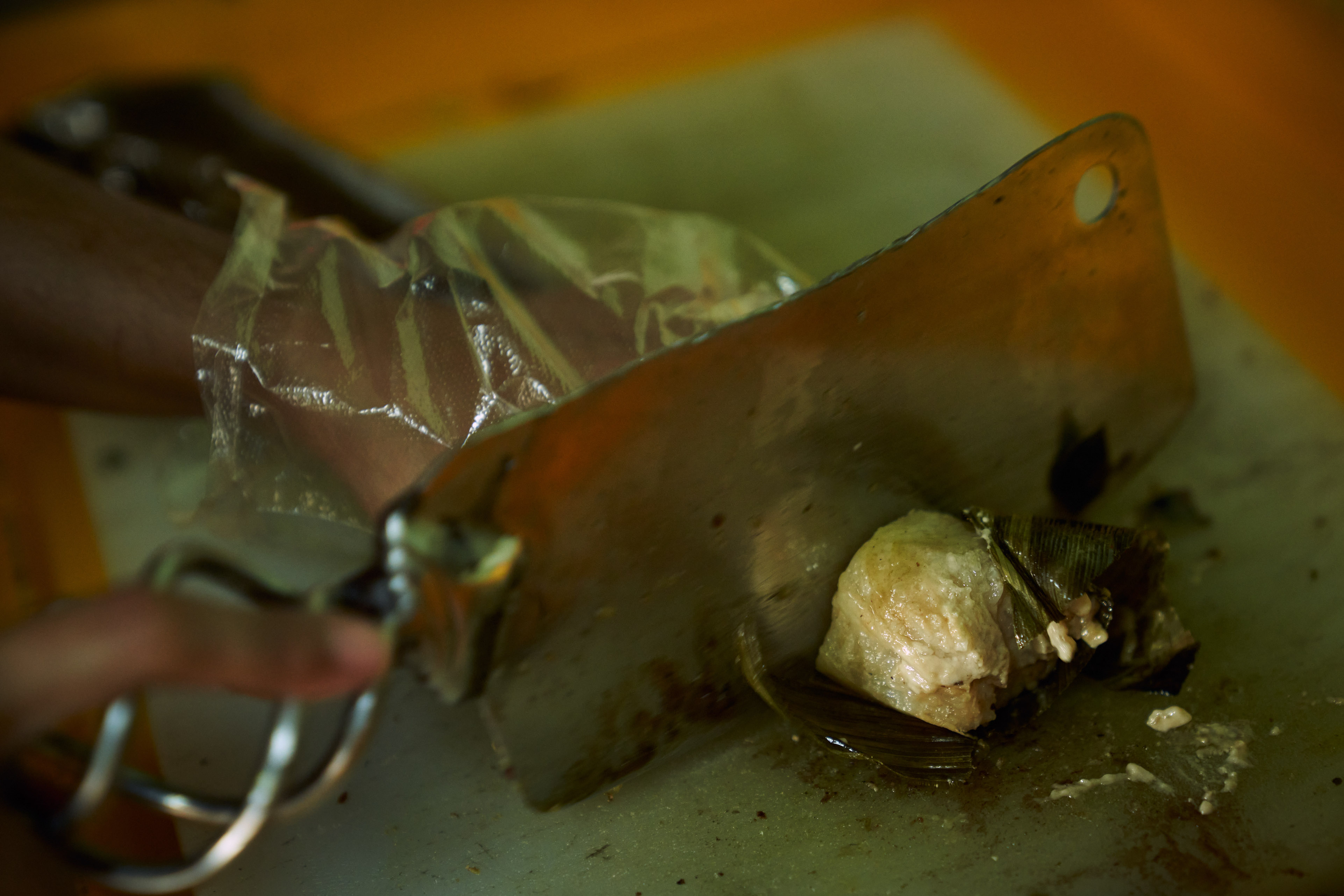


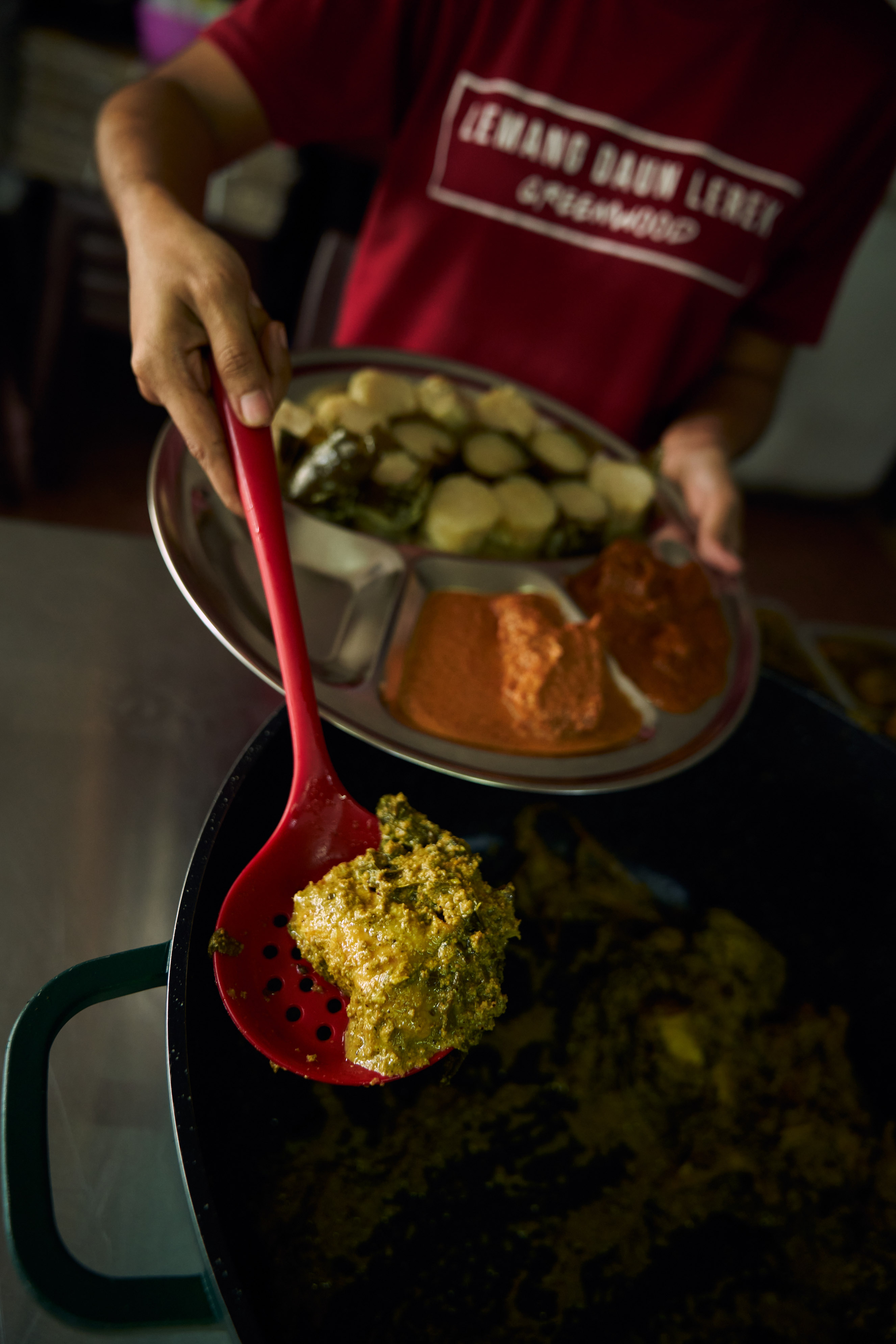

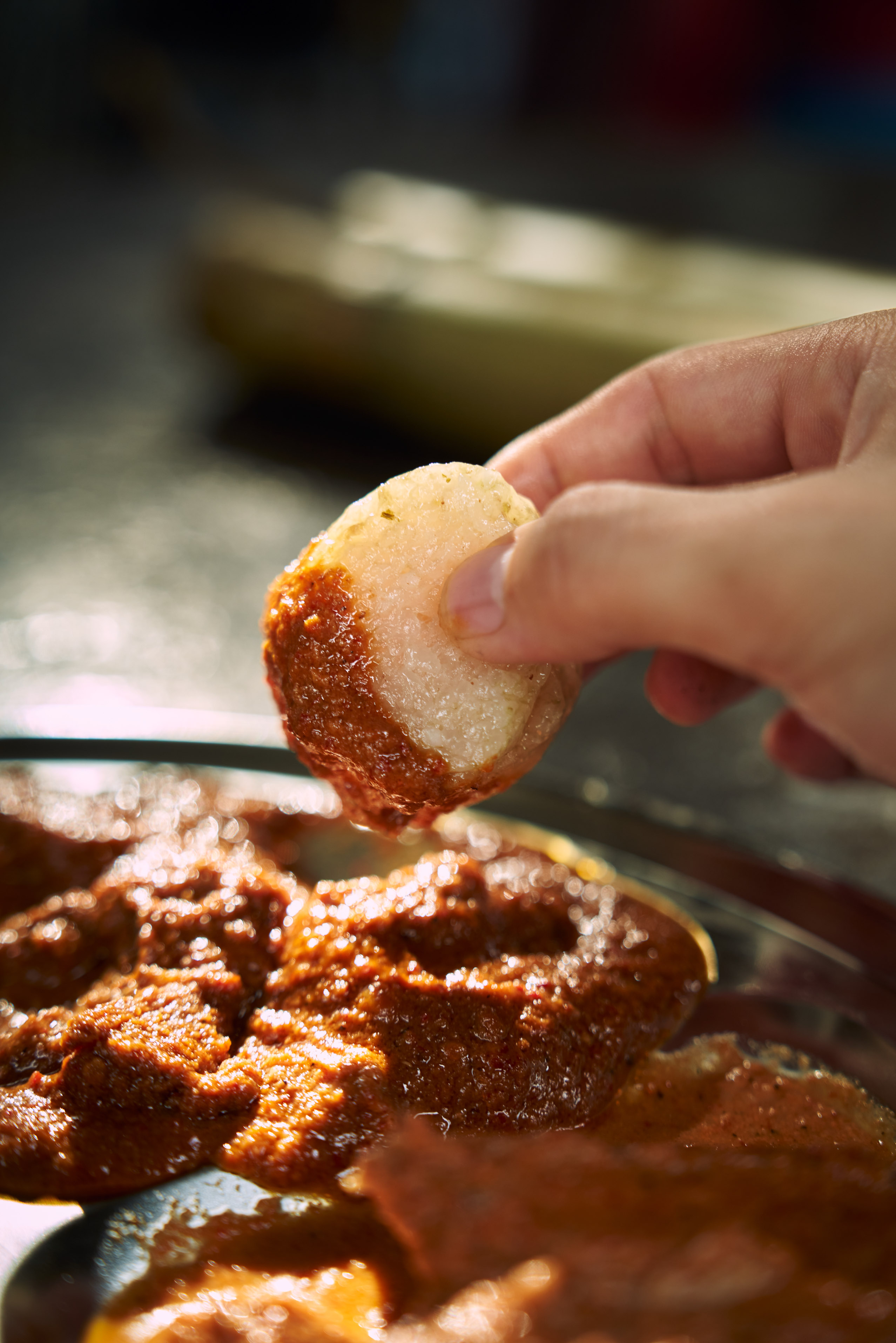
可都拔 Ketupat
不同於東南亞華人或台灣所熟悉的裹粽型態,馬來社會的「可都拔」(ketupat) 材料簡單,只需白米,或者糯米也行。該食物常見於東南亞穆斯林的開齋節慶場合,也在日常市集可見以不同形狀大小來搭配燒烤肉串的販售。基於製法概念類似華人以植物葉子裹著米飯蒸煮的手法,因此當地華人也習慣以「馬來粽」通稱。然而可都拔這一食物也不完全專屬馬來穆斯林的吃法,而相鄰的婆羅洲、印尼群島和新加坡等也可看到這類粽食的身影,反映米食跨越國界的文化動態。
可都拔究竟專屬哪國食物,坊間有許多説法。大致認為可都拔源自於印尼爪哇,見證15世紀伊斯蘭教傳入爪哇社會後取代印度教的政經脈絡。根據爪哇地方誌的記載,當地九大聖人(Wali Songo)之一的蘇南‧卡里嘉賈(Sunan Kalijaga)透過伊斯蘭傳教管道引入可都拔,成為後來穆斯林慶祝開齋節的必備食品。不同於當代開齋節,爪哇伊斯蘭王朝創建時期的可都拔原先是設定在齋戒月結束後的一週才進行製作,也就是伊斯蘭曆法十月的第八天(8 Syawal),代表著家族成員在齋戒結束後重新團聚與共享歡樂的開齋進食意義。小至家族再到社區村落層級的群聚場合,參與者皆共同實作可都拔的烹製儀式。除了米飯本身,粽囊的編織也很重要,強調成員在編織過程中的社會互動與知識交換。效仿草蓆的編織法其橫縱交錯的紋路也象徵人類生命的過失與罪惡,並以純白的米飯填滿粽囊來象徵心靈洗滌與反思過錯的意象。編織好的粽囊再獻上給長者,代表他們作為一個集體社會的向心力和團結意涵。可都拔的粽囊本體多為菱形,從核心往外衍生四個尖角。食物的外形也反映了族群如何透過飲食來闡釋生命哲學和宇宙觀,甚至映照爪哇社會的宗教信念。以可都拔為例,粽囊的四角代表著東南西北四個方位,其形體對應的是一個指南針,反映穆斯林以朝觐麥加聖堂(kiblat)為人生信仰目標;另外,伊斯蘭教義相信人在降世之時是由四種環境元素,既風、火、土與水(papat kalima pancer)結合,向內凝聚成為具有慾望和行動能力的人類軀體,如粽囊中心所代表的肉身意象。
從可都拔在東南亞民間流傳的歷史境遇,可見這道米食在地緣政治擴張與族群身份認同之間衍生出多元的詮釋路徑。與其將可都拔歸類為特定國族的專屬食物,反而更重要的是米食文化和編織裹食的技術如何呈現長時間跨度上的流動關係。無論是口述歷史或非官方文字記載,可都拔皆在不同的宗教儀式場域中出現,透過小小的粽囊來見證泛馬來族群在印尼群島與馬來半島之間的跨境遷徙經驗,皆無法被單一化約在當代官方單位所劃界認定的族群宗教等治理範疇中。早在中世紀位於蘇門答臘的室利佛逝(Srivijaya)王國盛世之時,佛教徒的慶典儀式上就已見有可都拔這類裹粽主食,甚至信仰印度教的馬來社會也將可都拔視為象徵純潔的儀式食物。峇里島社會在70年代開始盛行一種以可都拔為特有的大亂鬥節日(Perang Ketupat),直到今日成為當地峇里島的年度觀光盛典。該儀式主要為了彰顯國泰民安,並且透過向對方互相丟擲可都拔的舉動來宣揚創世主的恩惠。米粒被認為是物產豐收與社會安穩的表徵,藉由互相丟擲的身體展演動作來表達現場參與者們的快樂情緒和感恩心態,並在儀式之後共同分享食用向大眾丟擲的可都拔。
當代可都拔的製作形式也考量取材環境和製作用途的改變而呈現多元的面貌。馬來西亞的可都拔是其中一種較為常見的馬來粽,還有一種是打拜(Tapai),因形狀大小或裹粽材料的不同而衍生的種類。可都拔的粽囊是飽滿的菱形,但打拜是略扁的三角形。另外,可都拔主要採用嫩綠的椰葉,以草蓆編織的方法來織成一個方形粽囊;至於打拜則以羽狀棕櫚葉來綁紮。棕櫚樹的羽葉每根有數枝骨幹,張開來有數寸的闊度,足夠完整包裹一個飯糰的容量,因此一個打拜的份量只需要一片羽葉即可。當棕囊成形並留下一個活結小孔,再從空隙口塞入米粒。這些並非為生米粒,而是事先以椰漿調和煮過的半熟米。當粽囊塞滿米粒,便將活結拉緊讓葉子緊裹住,再於末端打上小結來防止烹煮時漏出。米粽在下鍋前會分作數顆為一束,以便於取出和數量計算。
可都拔棕囊的編織也可看出飲食文化的創意活力與符號象徵。菱形棕囊是典型的編器設計,但不僅限於此形狀。早期的菱形米粽囊承載著伊斯蘭宗教信仰的哲學觀念,體現一個社會的集體共識與信念;當代的米粽消費市場出現許多不同形狀造型的可都拔棕囊,強調的是個人的編織技術和創意能力,反映可都拔從過去的神聖性儀式象徵衍變至今世俗表徵的米食經濟文化。
壓製飯塊(nasi impit)類似於可都拔和打拜,呈現米飯的簡單滋味。但是飯塊的呈現不同於後者,不需經過編織與裹紮程序。中譯名稱可清楚顯示其形狀與製作特性。不同地區之間在名稱上並非統一,有者稱為 himpit 或 kapit,但意思和 impit 一樣都指涉這道米食主要的「壓製」塑形手法。飯塊在馬來西亞多以花生炒製的沙嗲醬來作搭配,因此米飯本身不需經由特別調味,或者在米飯蒸煮過程中加些許的肉桂與八角即可。將煮熟的米飯倒入鋪好香蕉葉的容器內,並壓製成一大塊四方成形的飯糰,再切成方形小塊狀以方便隨身攜帶與進食時入口。
Ketupat
Different from the rice dumplings that the Chinese people in Southeast Asia or Taiwan are familiar with, ketupat of Malay communities have simple ingredients, consisting of only rice or glutinous rice. Ketupat is commonly found in Eid al-Fitr ceremonies among Muslim communities in Southeast Asia and is sold at daily markets in various shapes and sizes with kebabs. As the ketupat is also a rice dish wrapped in leaves, local Chinese people refer to it as the Malay rice dumpling. Yet, ketupat is not exactly exclusive to Malay Muslims as similar variations can also be found in the neighboring areas of Borneo, Indonesia, and Singapore, reflecting a cultural landscape of rice transcending borders.
There are many interpretations regarding the origin of ketupat, but most believe its birthplace to be Java, Indonesia, which corresponds with the political and economic background of Islam entering the Java society in the 15th Century and thereby replacing Hinduism. According to the chorography of Java, one of the Wali Songo (nine saints) of Javanese Islam – Sunan Kalijaga – introduced ketupat through Muslim missionaries, and ketupat later became a staple for Muslim communities celebrating Eid al-Fitr. Unlike modern Eid al-Fitr customs, ketupat was originally produced one week after Ramadan or 8 Syawal (October 8th of the Islamic calendar) during ancient times, specifically when a Muslim empire took over Java. Making ketupat on 8 Syawal was symbolic as it was when family members reunited after Ramadan to feast together. Units as small as families and as large as villages or communities would gather together to help make the ketupat. It wasn’t just the rice that was significant. How the leaf pouch was woven was also equally important because it emphasized the social interactions and exchange of knowledge among participants while making ketupat. The interwoven leaves inspired by straw mats are also representative of mistakes and sins throughout the course of human life, while the pure, white rice filling the leaf pouch symbolizes the cleansing of the soul and penance of past sins. The woven leaf pouches are then presented to elders of the community to signify the community’s strength in unity. The majority of ketupats are diamond-shaped, with four corners growing from the core, which reflects how ethnic groups interpret their philosophy of life, cosmogony, and even religious beliefs in the Javanese society. Using the ketupat as an example, the four corners of the leaf pouch represent the four directions of North, East, South, and West to symbolize a compass, reflecting the Muslim firm devotion to kiblat (direction towards the Kaaba in the Sacred Mosque in Mecca). Islam also believes the human body is formed and consists of four elements, namely wind, fire, water, and earth (papat kalima pancer). The four elements come together to create a human form with desires and the ability to carry out their lives, just as the ketupat core symbolizes corporeal forms.
The history of ketupat in Southeast Asia is evidence of its diverse nature throughout the expansion of geopolitics and ethnic identity. What is critical is not labeling ketupat as the food of a certain nation or ethnicity but rather how rice culture and techniques of wrapping food in woven leaves have migrated throughout a long period of time. Ketupat can be found in various religious settings in both oral history and unofficial written records and is, therefore, a testimony to the migratory experience of Malays across Indonesian islands and the Malay peninsula, which means it cannot be demarcated into any single officially recognized ethnicities or religions. These wrapped staple foods can be found in Buddhist ceremonies of the middle ages, specifically in Srivijaya, a Malay Buddhist thalassocratic empire based on the island of Sumatra. Even Malay communities that believe in Hinduism consider ketupat as a ceremonial food symbolic of purity. During the 70s, the Balinese society started celebrating and popularizing Perang Ketupat (ketupat war), which has now become one of the biggest events in Bali each year. Perang Ketupat celebrates peace and prosperity in Malaysia and its people and extolls the glory of their creator god by throwing ketupats at other people. As rice is often considered a symbol of social stability and abundance, the physical act of throwing ketupat expresses the joy and gratitude of all participants. After the ceremony, everyone will feast on the ketupats thrown in the Perang Ketupat.
Modern ketupats have also evolved into diverse sizes and shapes to correspond with different environments and purposes. A less common Malay rice dumpling than the ketupat is tapai, a rice dumpling hatched for different shapes, sizes, and materials, i.e., ketupat is a robust diamond shape, while tapai is a flatter triangular rice dumpling. In addition, ketupat primarily uses lush green coconut leaves woven using straw mat weaving techniques into a square shape, but tapai is wrapped with palm leaves shaped like a feather. Each palm leaf consists of multiple leaflets that span a width of multiple inches, enough to contain a single serving of rice dumpling, and so one leaflet is the equivalent of one rice dumpling. The leaflet is first shaped into a flat triangle, leaving a small opening for stuffing in the rice. The rice filling for tapai is not raw but semi-cooked rice boiled in coconut milk. After the rice is stuffed into the leaflet, a preformed slipknot is tightened to enclose the rice, and another knot is tied on the ends to prevent leakage during cooking. Multiple tapais will be tied together before being placed into the pot for easy access and counting.
Weaving on the ketupat is also a manifestation of creativity and symbolism in local dietary cultures. A diamond-shaped leaf pouch is a classic design but not the only one by far. The earliest diamond-shaped leaf pouches carried the philosophical ideologies of the Islamic faith and manifested society’s consensus and beliefs. In the present day, different ketupat shapes spotlight an individual’s weaving skills and creativity, reflecting the evolution of ketupat as a sacred ceremonial food into a symbol of the secular rice economy and culture.
Nasi impit (compressed rice) is similar to ketupat and tapai in the way it presents the simplest flavors of rice but doesn’t require any of the complex weaving or wrapping process. The literal translation clearly indicates its shape and production process. Nasi impit goes by different names in different regions; some call it nasi himpit or nasi kapit, which all implies, as nasi impit does, the crucial technique of compressing the rice. In Malaysia, nasi impit is largely served with satay (peanut sauce), and so the rice itself is not further seasoned other than the occasional addition of cinnamon and star anise. The steps for making nasi impit are as follows: spread cooked rice over a container covered with banana leaves, compress to form a large square shape, and then cut into smaller bite-sized square shapes for portability and convenience.
西米 Sagu
將視角從馬來半島移往位於婆羅洲的東馬地區,其中砂拉越原住民族社會的主食文化呈現了澱粉攝取來源的不同面貌。首先,雨林山區地形使得砂拉越常見以旱稻種植(takaa)為主。地方農戶的旱稻農作一般以自家糧食供應為己用,鮮少進行大規模收成的外銷用途。然而,並非所有原住民家戶都有能力投入人力來進行開墾與經營旱稻農地,而且土地劃分本身也牽涉了複雜的資源所有權分配的環境政治問題。因此,除了稻米之外,西米(sagu)既是另一種常見於當地家戶餐桌上的澱粉主食。
Sagu
As we turn our attention from the Malay Peninsula to Borneo of Eastern Malaysia, we can see that the staple food of indigenous communities in Sarawak is a drastically different source of starch from the rest of Malaysia. The mountainous rain forest landscapes found in Sarawak mean that the most common rice cultivation is takaa (aerobic rice cultivation). Local farmers usually grow rice crops for their own use and rarely harvest in bulk for sale. Yet, not all indigenous households have the labor or resources to cultivate land and grow aerobic rice. Land zoning, in and of itself, is a complex issue of resource allocation and environmental politics. As such, sagu is another common staple food found in many local households in addition to rice.
臺灣社會對於西米這一食材或許不陌生,可在一般東南亞甜品中品嚐過半透明的小圓球膠質狀物。雖然這種西米是經過多重加工後製的食材形態,但它的原料也是萃取來自熱帶的棕櫚樹幹。棕櫚樹內部所產的澱粉物質,適合提供人類的碳水化合物所需。在砂拉越原住民族社會裡,一般所採集的西米澱粉源自於棕櫚科的厚壁椰屬(Eugeissona),並根據植物外形上來區分俗名,如有尖刺的棕櫚樹稱為 uvut,而沒有尖刺則稱為 lesei。
Taiwanese society will perhaps find sagu, a semi-transparent ball-shaped gelatinous ingredient often found in Southeast Asian desserts, to be quite familiar. Though the aforementioned type of sagu is a processed food, it is also derived from starch content in tropical palm trees, which is a great source of carbohydrates for humans. In the indigenous communities of Sarawak, most sagu starch is collected from Eugeissona, a clustering genus of flowering plant in the palm family. The palm trees are further distinguished based on the shape of the plant, e.g., palm trees with spiky thorns are called uvut, while palm trees without spiky thorns are called lesei.
西米澱粉在傳統上取代了米飯在砂拉越原住民族社會飲食中的主食角色。他們習慣藉由野外採集活動來尋找適合收割的西米棕櫚樹,並從原料萃取的始端來製作西米澱粉成品。然而近年來當地雨林環境面臨著不受控的林業伐木活動,導致野生的西米棕櫚樹的蹤影逐漸消失在族人們可自由採集的活動範圍內,使得家戶們無法在日常生活承擔這項澱粉生產的實作成本,轉為向市場直接購買商家量產的西米澱粉。野生自產和市面廠製的差別在於,後者在食品工廠經過後製漂白過程而成品呈現白色粉狀,反而原本家戶自產的西米則是棕褐色的粉狀外觀。這也在族人們餐桌上形成一個有趣的現象,既一般日常進餐時刻主要食用市售的白色西米澱粉,反而在重要節慶或家裡迎來貴賓或長老訪客時候才端出難以大量生產而更為價值珍貴的棕褐色天然西米。無論是市售或天然生產,西米澱粉是當地原住民族社會在外狩獵或採集活動時候取得碳水化合物的便利主食。相較於米飯,西米澱粉適合族人們長期在森林山區移動時攜帶在身,也便於保存和備食。只要混合於水,加以攪拌,即成為可食用的膠狀主食。
As far as traditions go, sagu has surpassed rice as the staple food of indigenous Sarawak communities. They are more used to looking for sago palm while gathering in the wild and then extracting the starch content to make sagu products. In recent years, the rain forests of Sarawak have been suffering from uncontrolled deforestation, and wild sago palms are gradually disappearing from areas where indigenous peoples can still freely gather food from. Many households can no longer afford the cost of processing sagu and have opted to purchase mass-produced sagu from markets. The difference between homemade sagu and manufactured sagu is that food processing plants will often bleach the sagu, creating a white flour rather than the brown hue found in homemade sagu. This has given rise to an interesting phenomenon: indigenous peoples will usually serve white sagu found in markets and will only bring out natural, brown sagu (invaluable because it’s impossible to produce in bulk) during specific rituals, and serve to important guests, or elders. Whether mass or naturally produced, sagu is a convenient staple food and source of carbohydrates for local indigenous peoples when hunting or gathering in the wild as it is easy to preserve and prepare; simply add a bit of water and stir for a gelatinous staple.
天然西米的萃取工序是先將野外已成熟的西米棕櫚樹砍下,並留下樹幹主體再將之切成四等份。接著有兩種傳統方式用來萃取西米澱粉質,一種是利用帶有釘狀表面的板子來進行研磨的方法,但該小面積的施力方法能完全萃取的澱粉份量有限;而另一種則是大面積的捶打方法,並透過重度施力在樹幹上破壞其厚壁組織纖維來取得澱粉質。在這過程中,族人會將水加入正被敲打破壞的纖維組織中,再在平面上以足部來不斷踩揉,直到澱粉流出再經過另一層藤製草蓆的過濾來完成最後的收集程序。
The extraction process for making natural sagu is first cutting down ripe palm trees in the wild. The trunk is divided into four sections and saved to extract the sagu. There are two traditional methods to extract sagu: the first method is using a grating surface to grind the sago palm, but it’s more time-consuming and inefficient as it can only focus on a small surface area and is unable to extract all starch content fully. The second method is crushing the sago palm trunk and applying pressure to break down the fibers. As workers are crushing the sago palm, other members of the community will pour water over the fibers being crushed and then step on the fibers on a flat surface until the starch flows out. The final step of the extraction process is filtering the starch through another layer of straw mat.


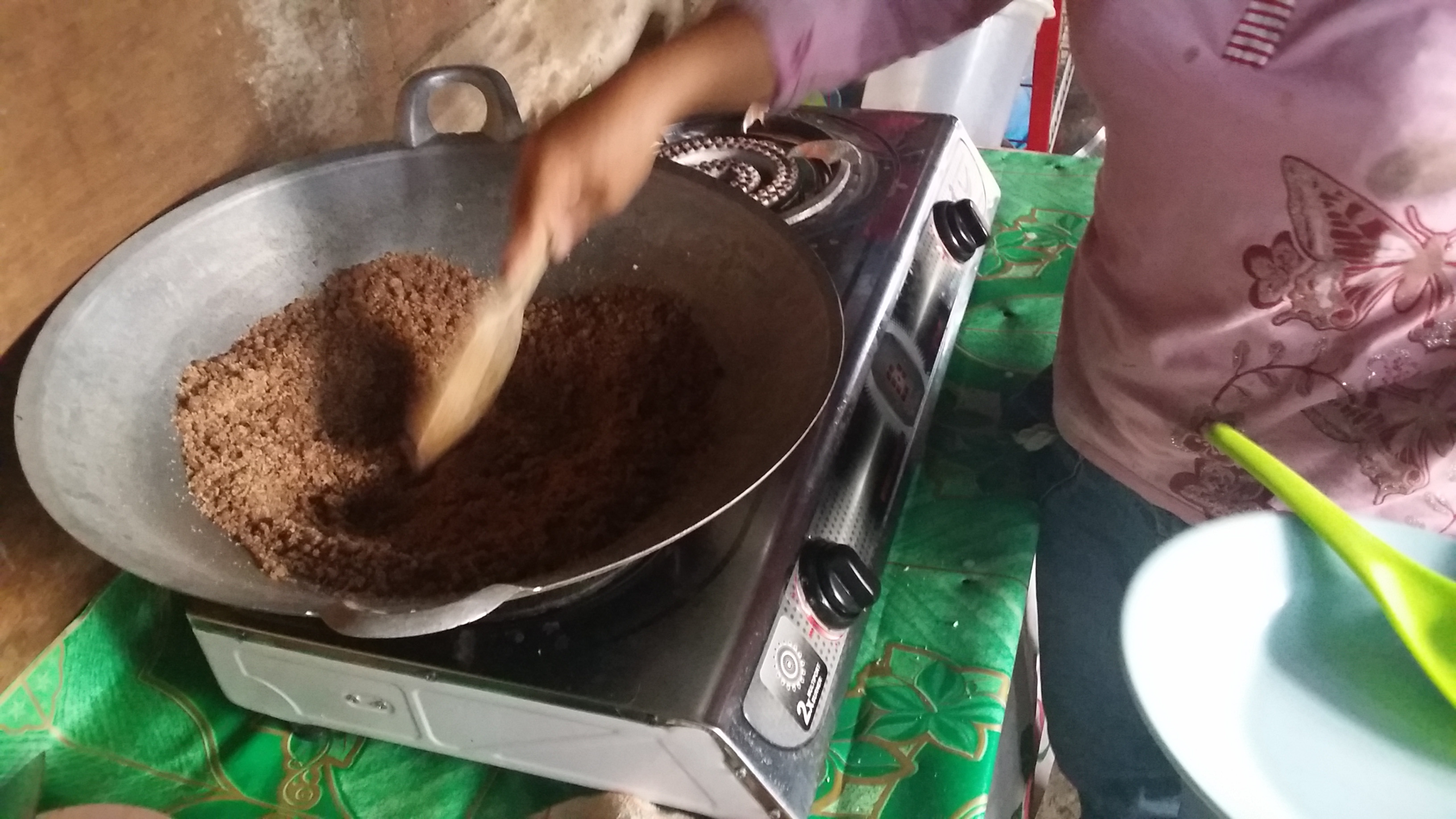
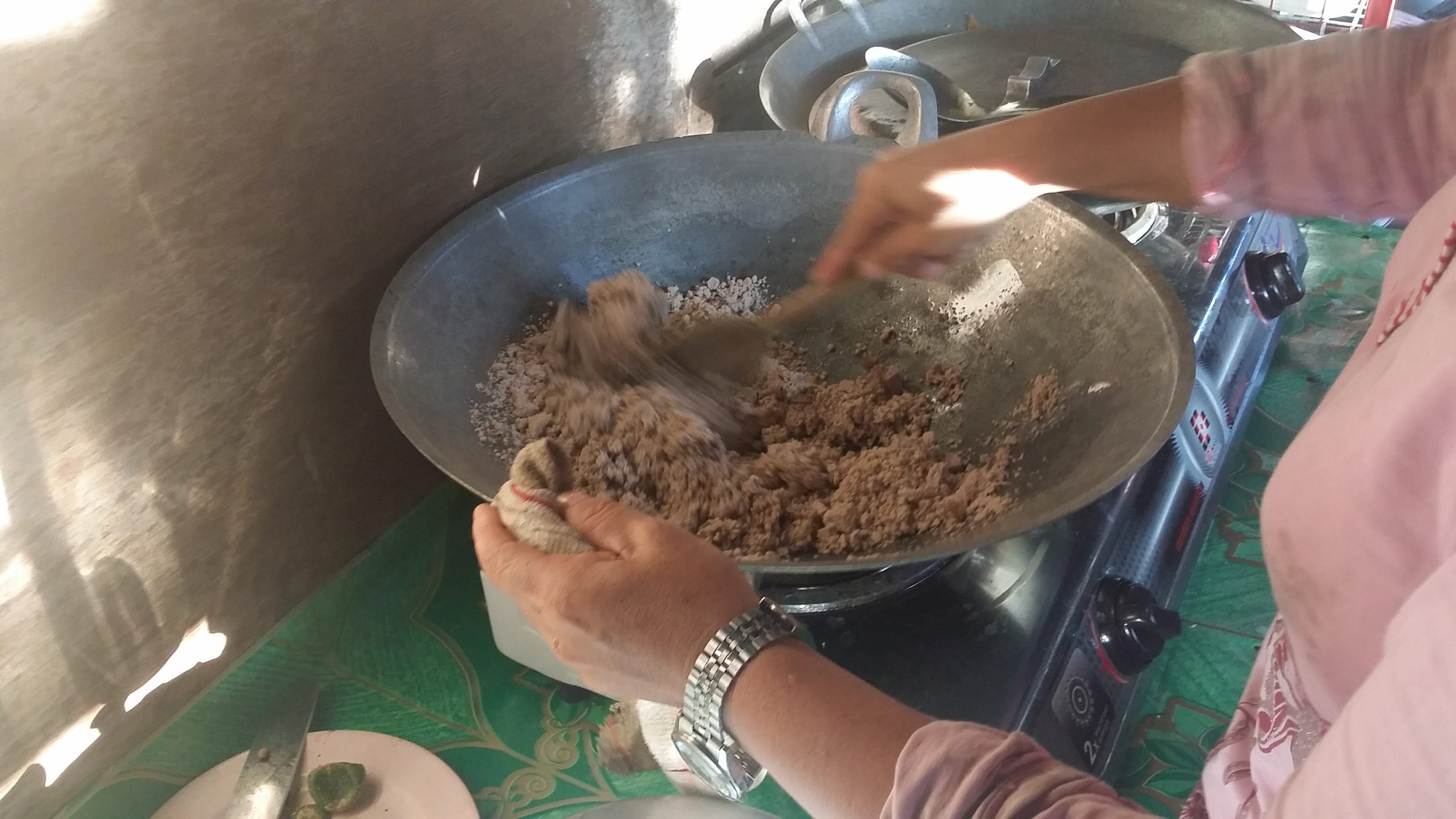



-
馬來半島因與周邊鄰近國家在族群宗教歷史上的羈絆關係,藉由長時間的遷徙流動過程而形成當代米食文化習性相近的面貌。究竟哪一方才是該米食的文化源頭,並非筆者本文所核心關注,反而傾向於留意米飯食物在當代不同國族身份上的文化詮釋空間。又,有些米食原先是在偶然的際遇下被創造,經由消費文化的不斷再製而衍生出如今代表某族群身份的具體食物。另,東馬的例子也挑戰我們對於米飯主食和飯糰的預設印象,從澱粉質的主體視角與當代環境發展變遷的議題來窺探西米所面對的現實挑戰,以及其至今仍然無法被其他食材所完全取代的文化內涵。
The Malay Peninsula is inextricably linked to surrounding countries because of ethnic and religious backgrounds. This connection has evolved and shaped the modern rice culture in Malaysia over long periods of migration and movement. The author is, therefore, utterly unconcerned with the cultural origins of any of the rice dishes but rather how different ethnic groups and cultures interpreted it. Some rice dishes were created as an accident but consistently reproduced to fulfill consumer demands and have now become representative of ethnic identities. The example from eastern Malaysia (Borneo) also challenges preconceived notions of rice and rice balls as staple foods and explores existing challenges sagu are currently facing from the perspective of starch and with topics on modern environmental development and changes as well as the cultural significance of sagu that makes it irreplaceable.